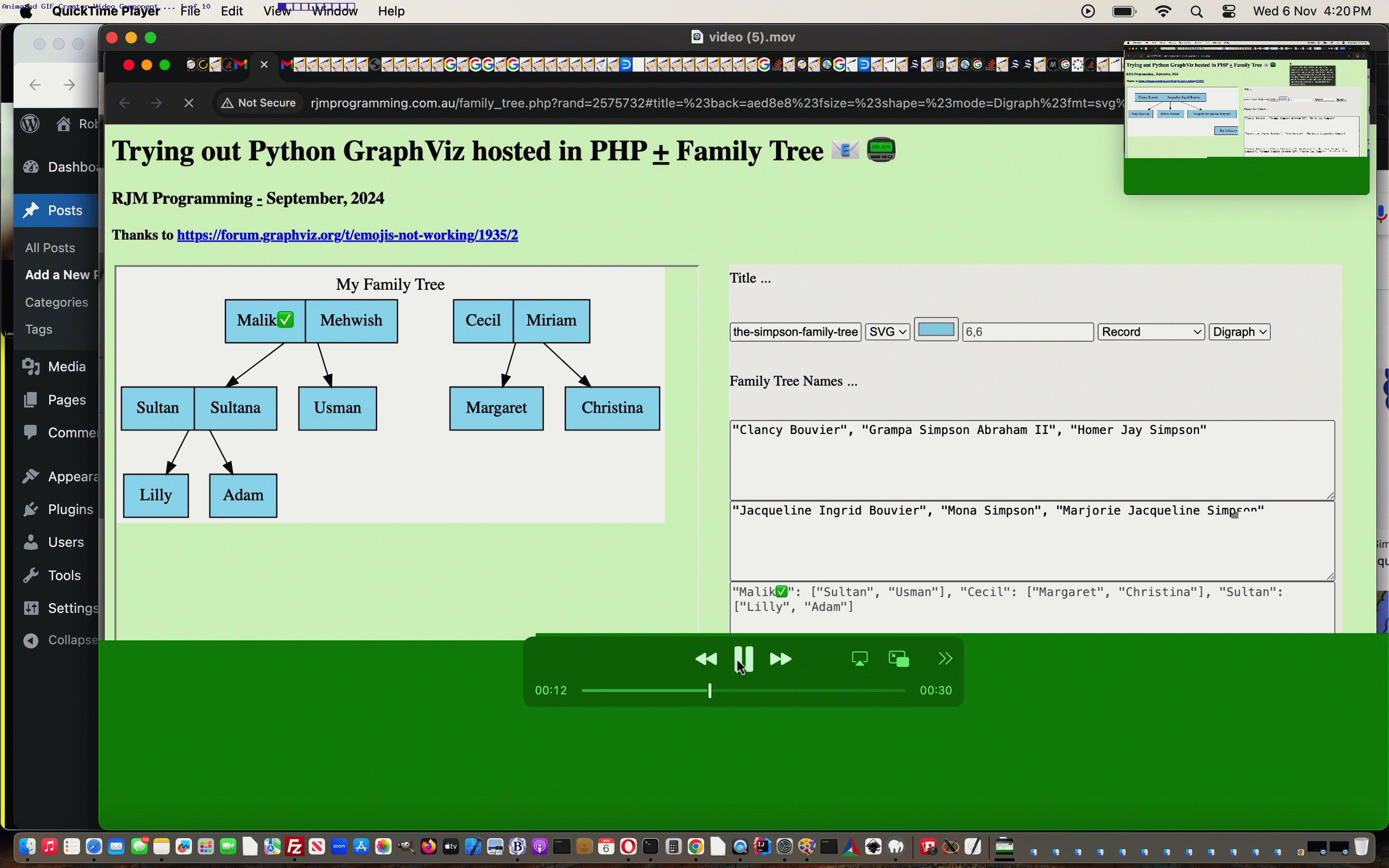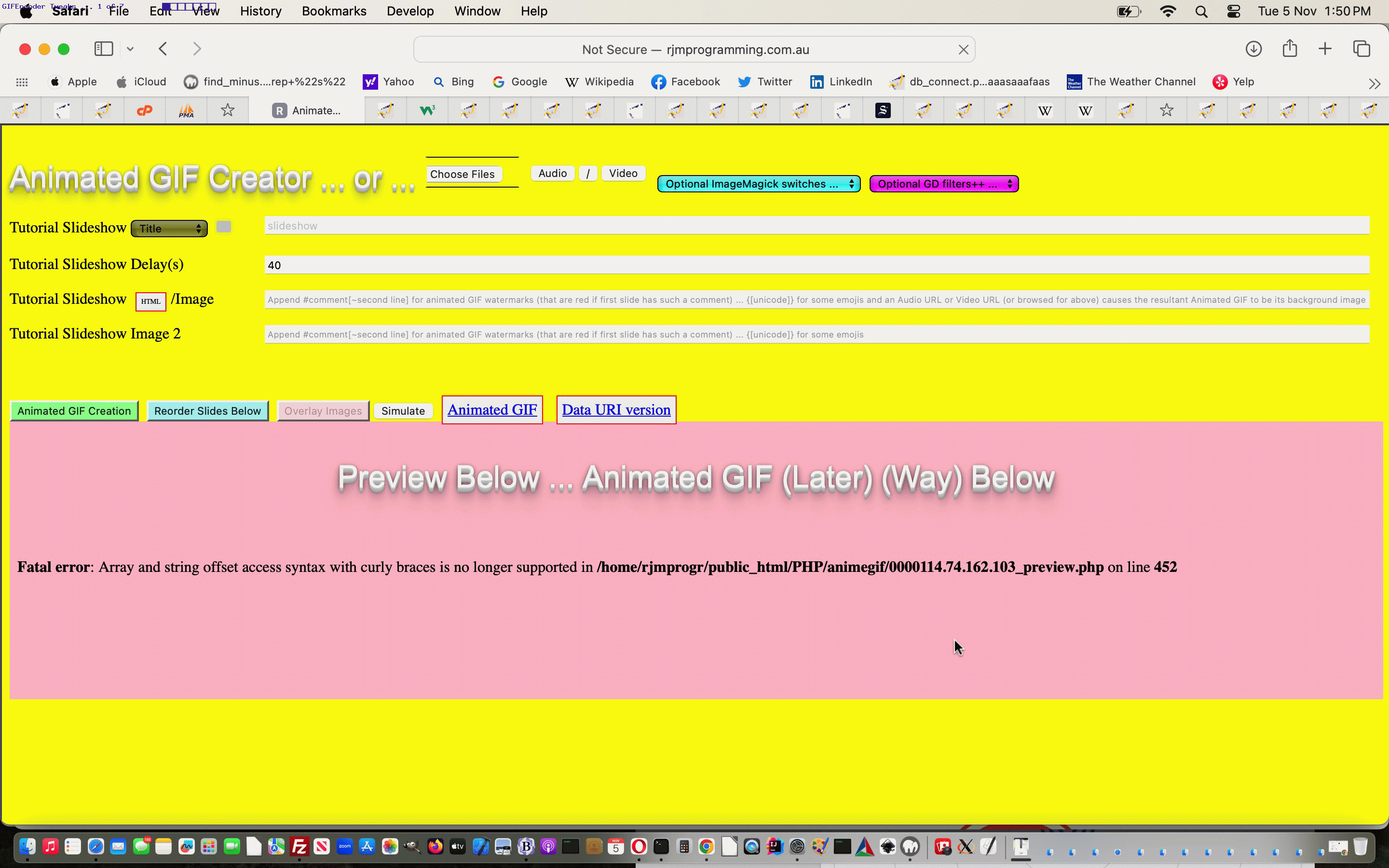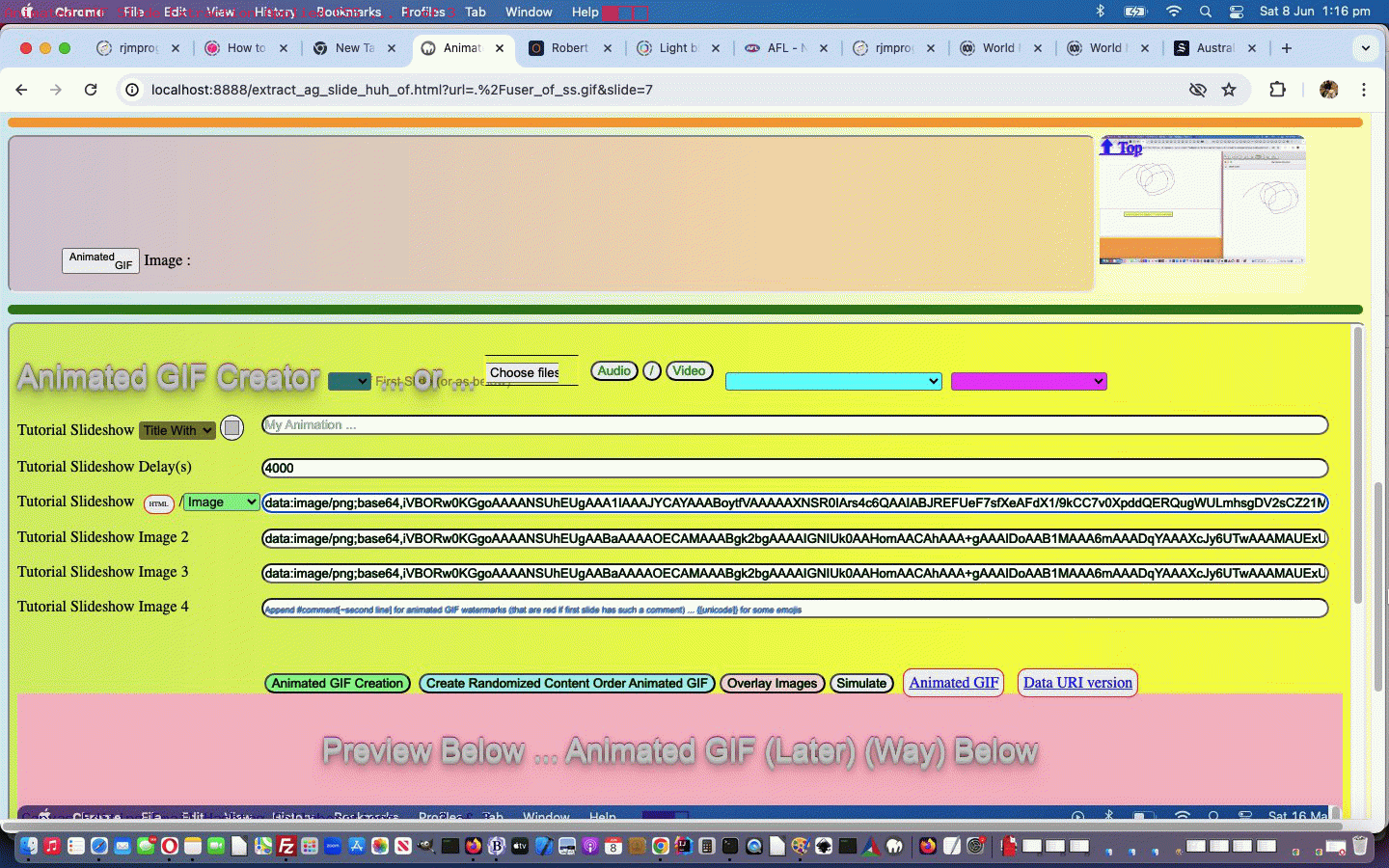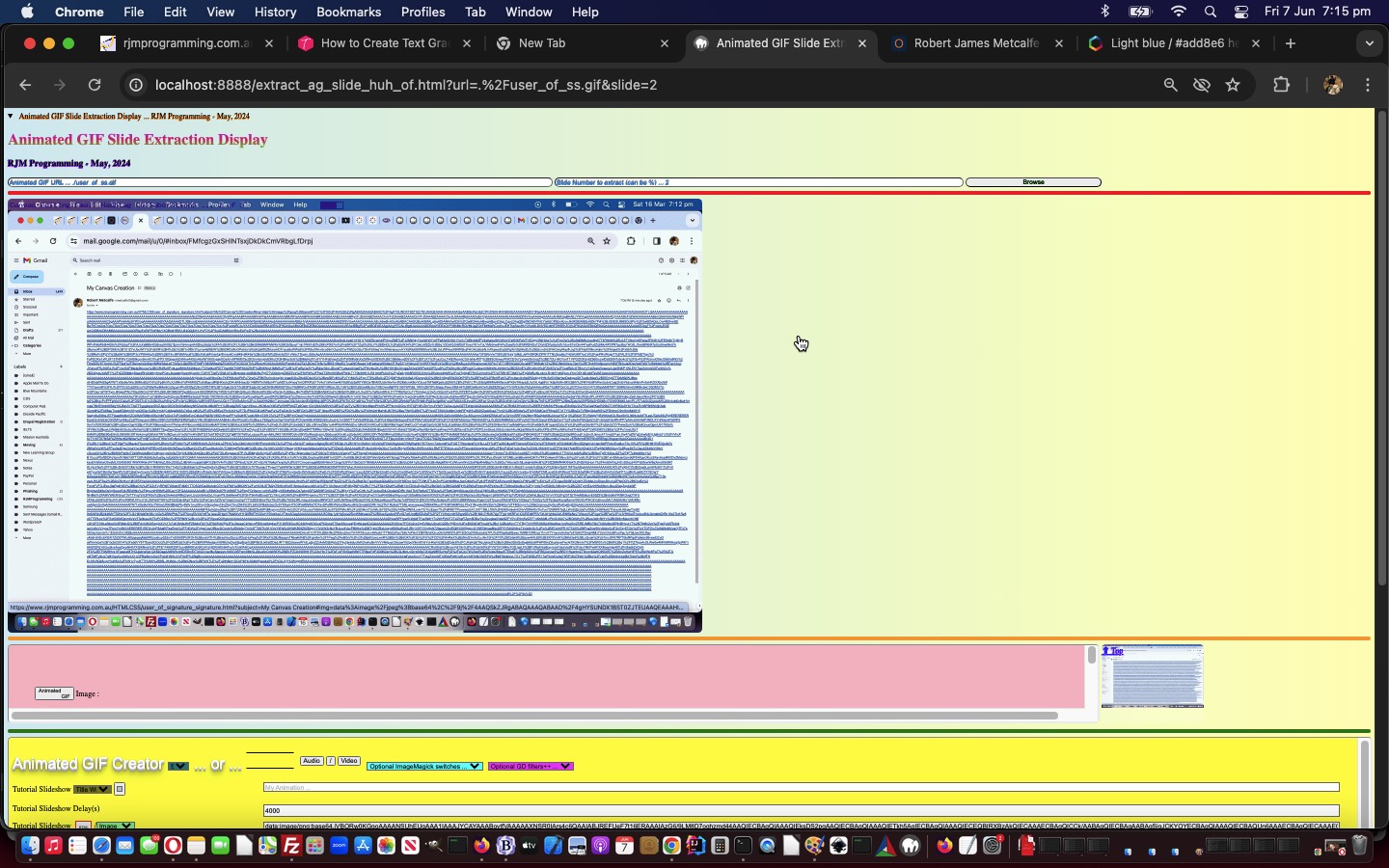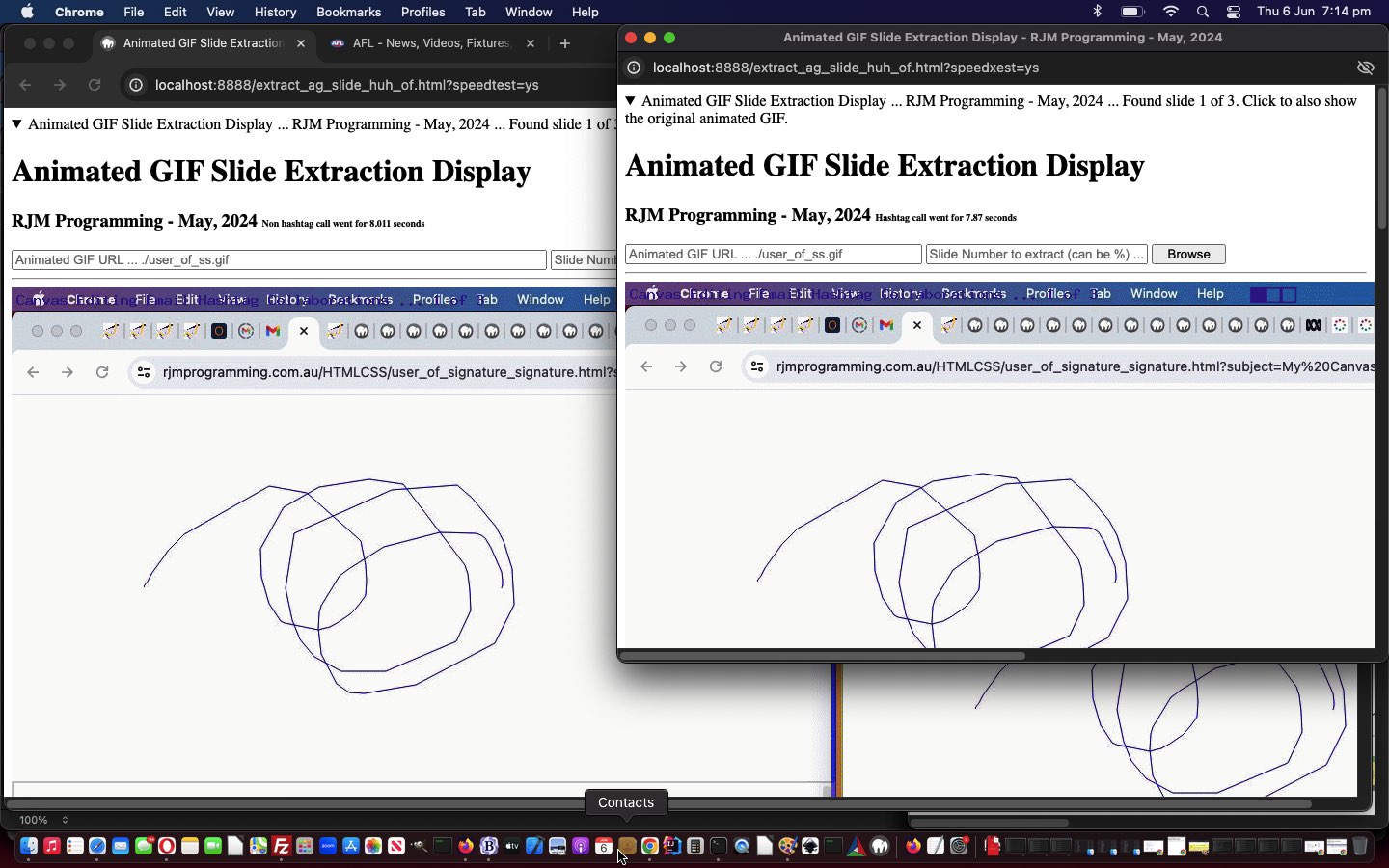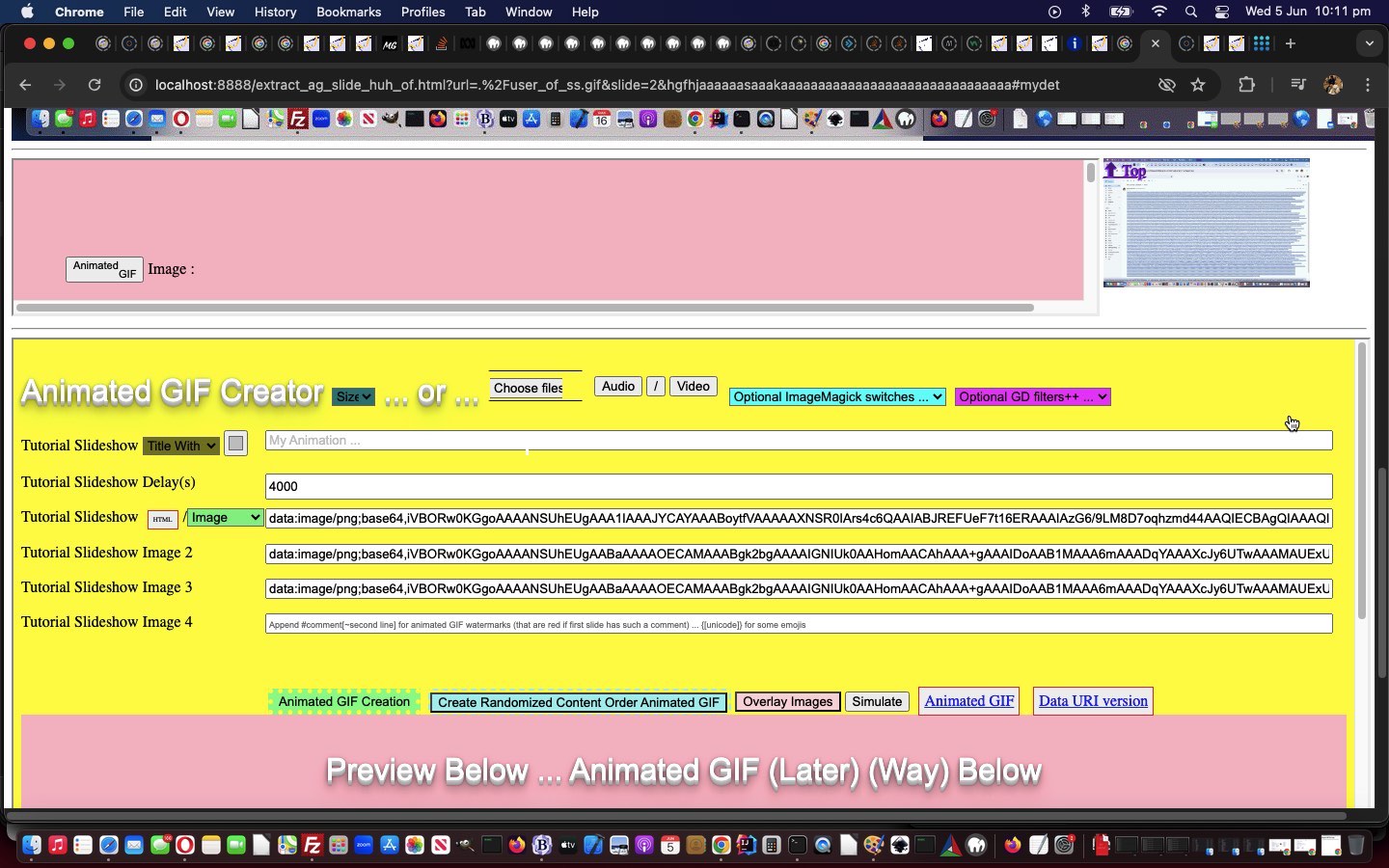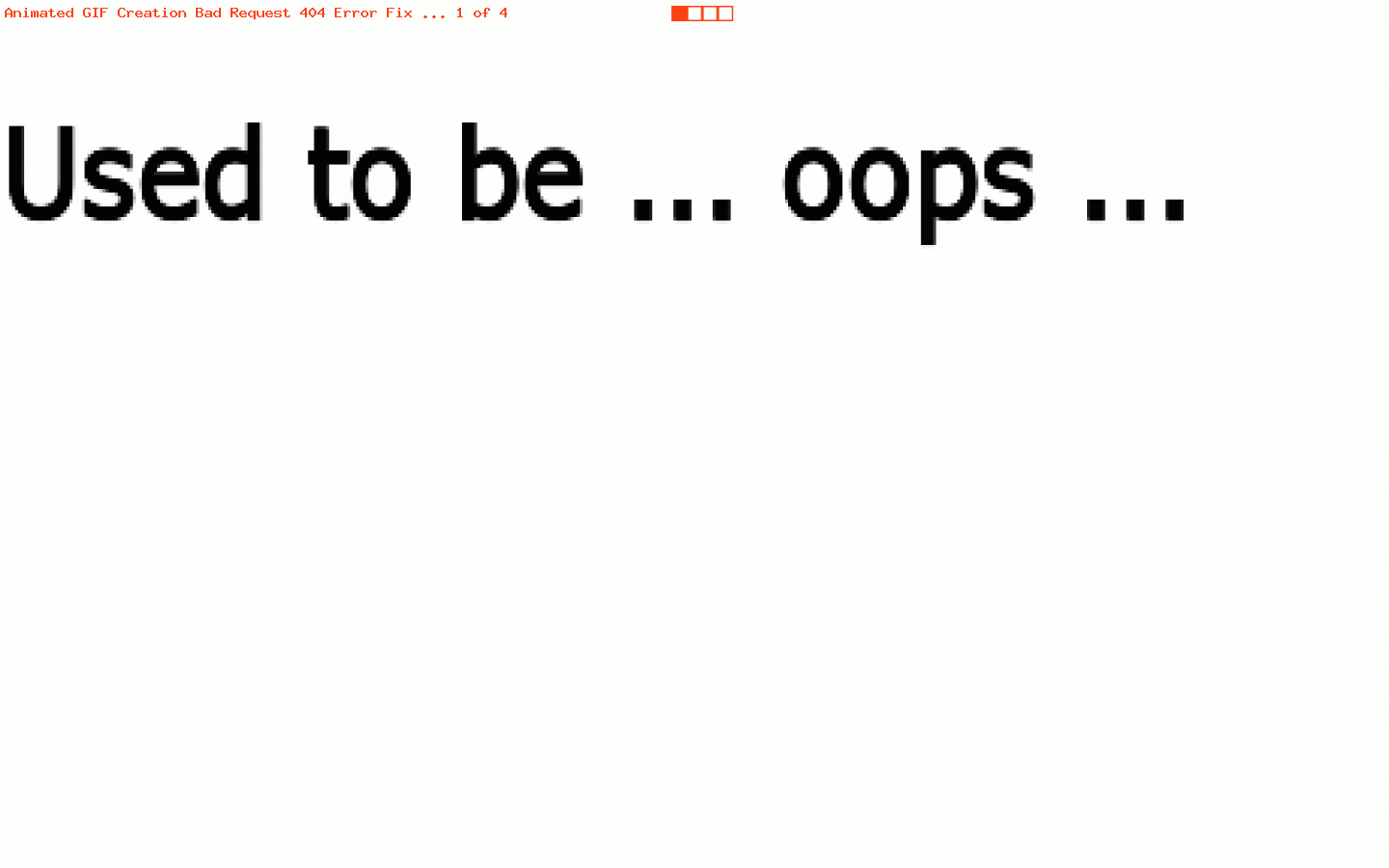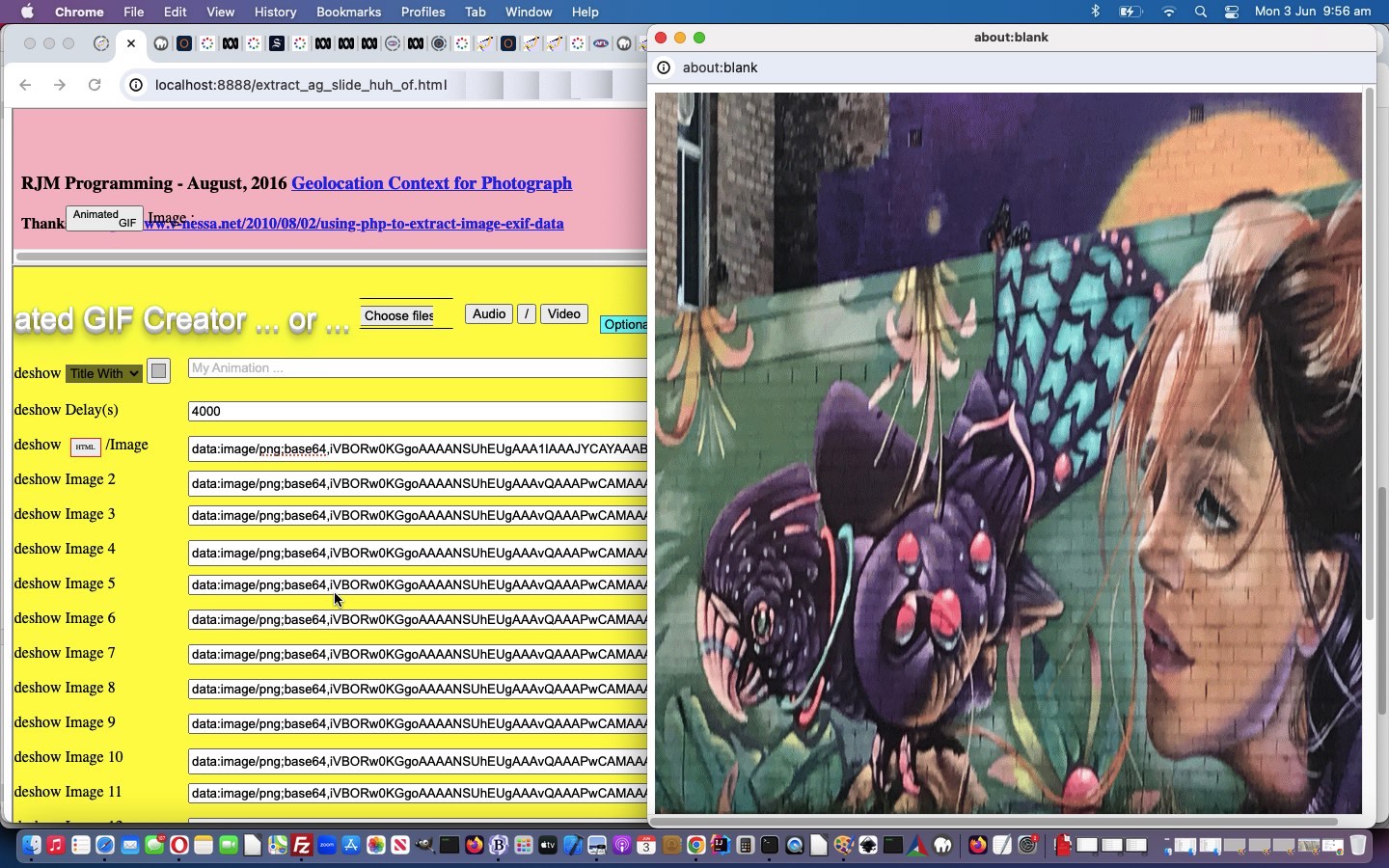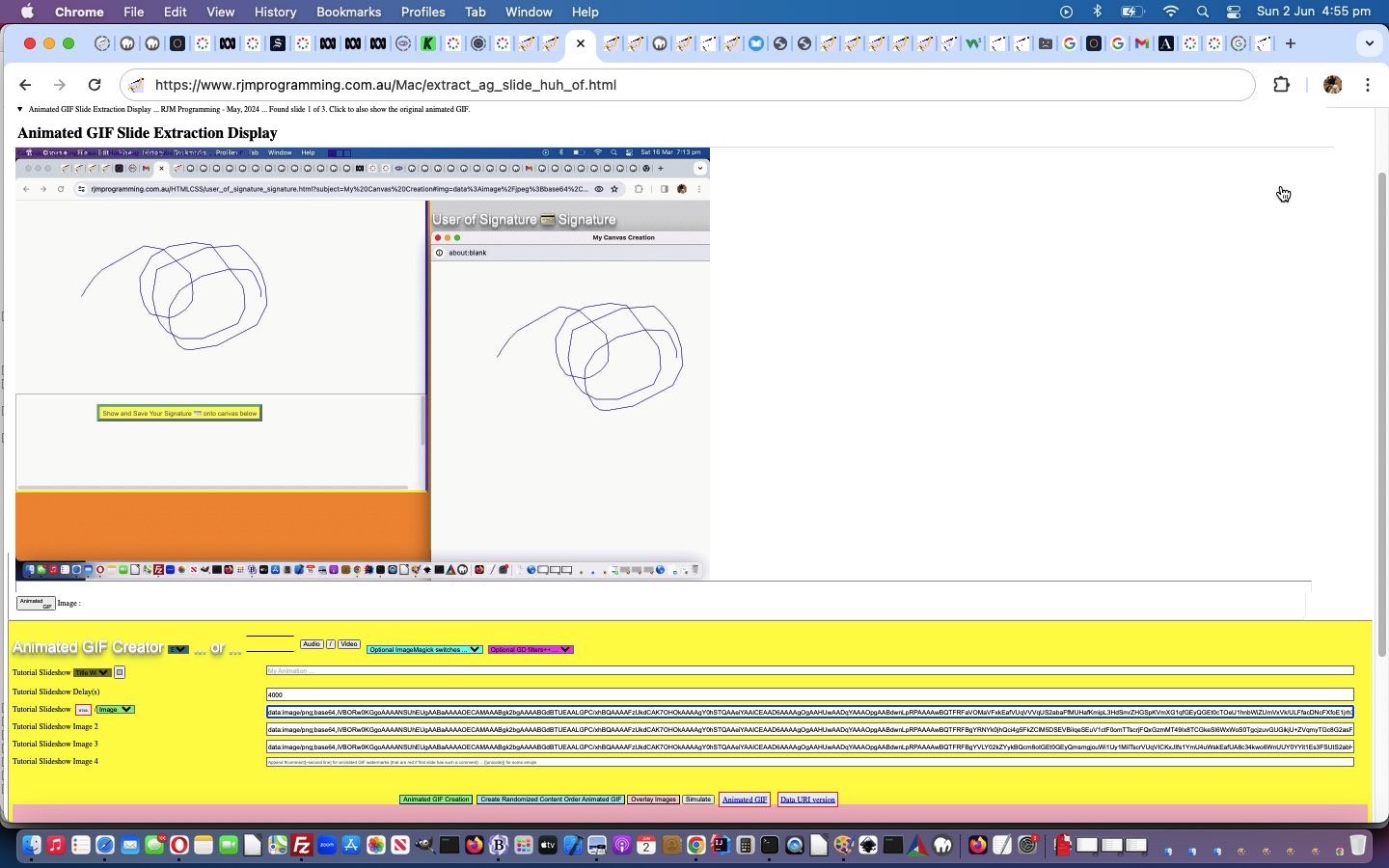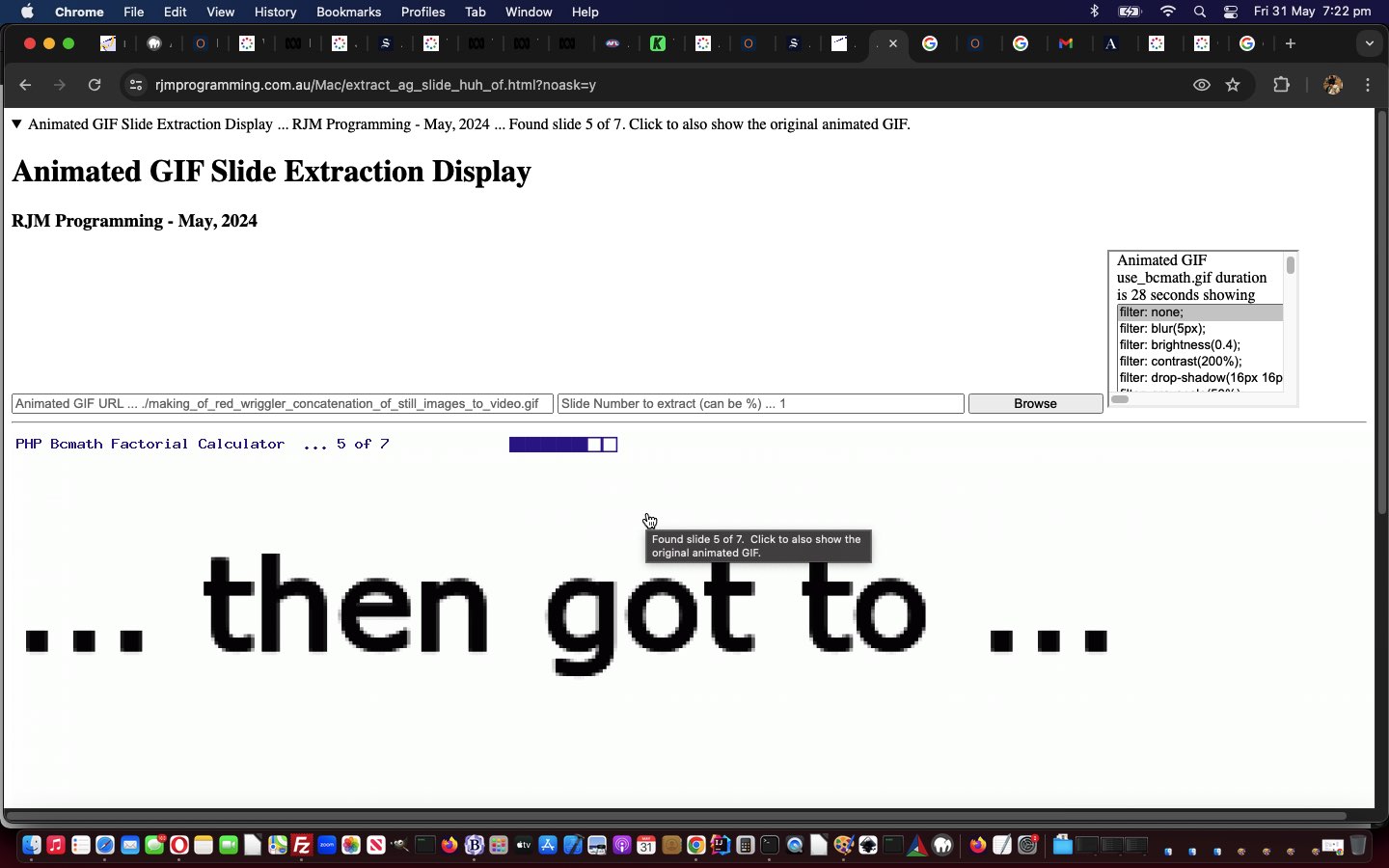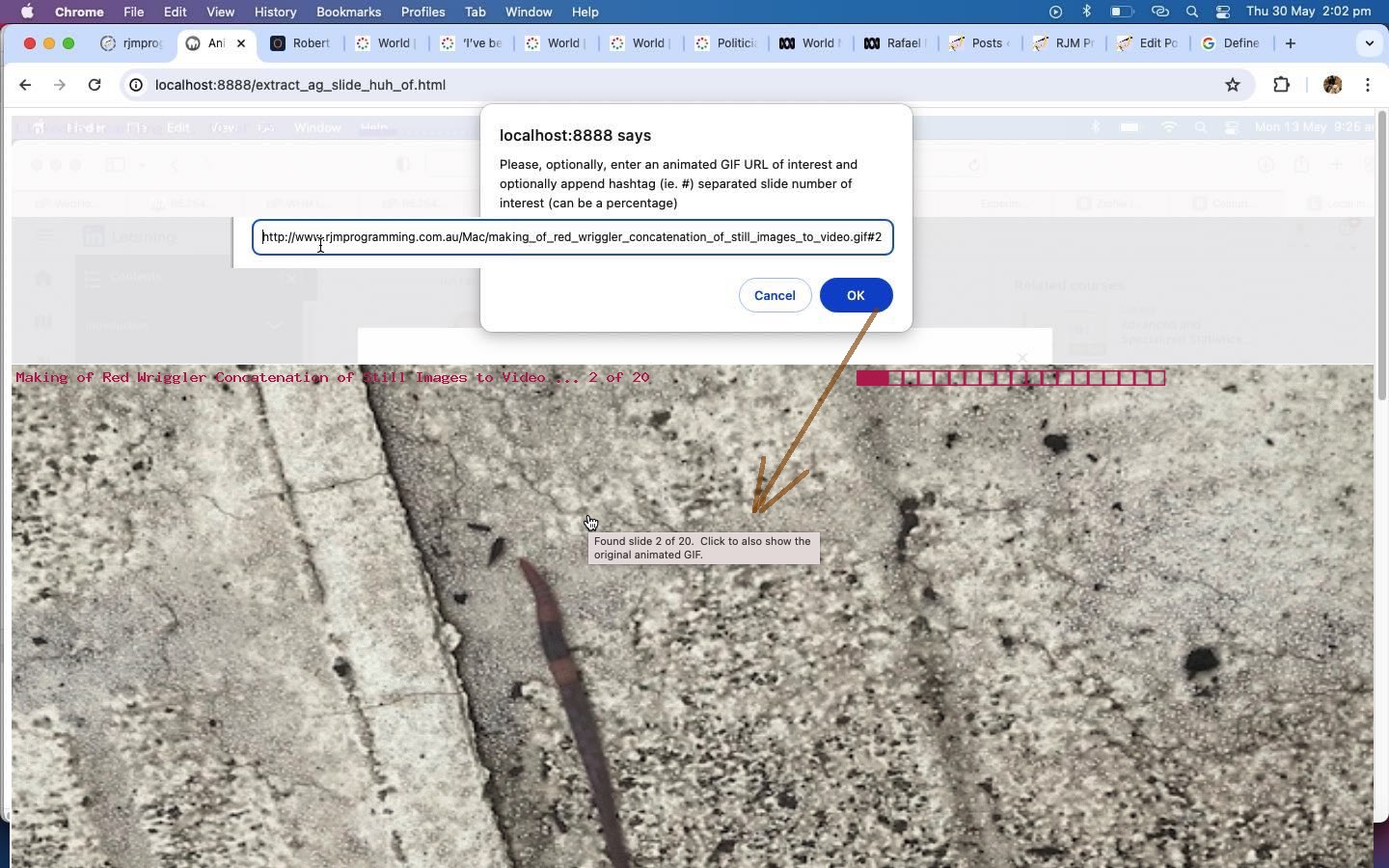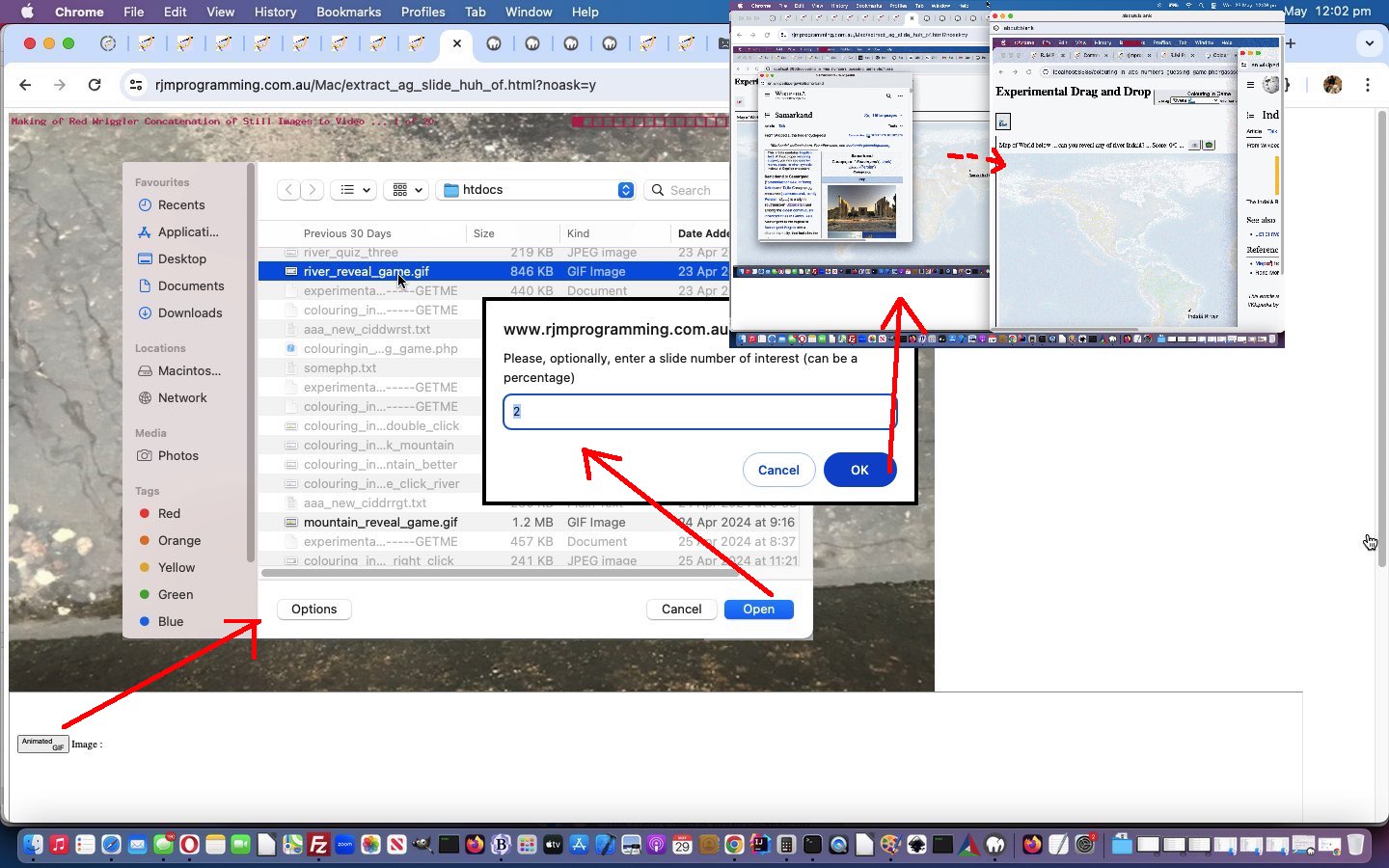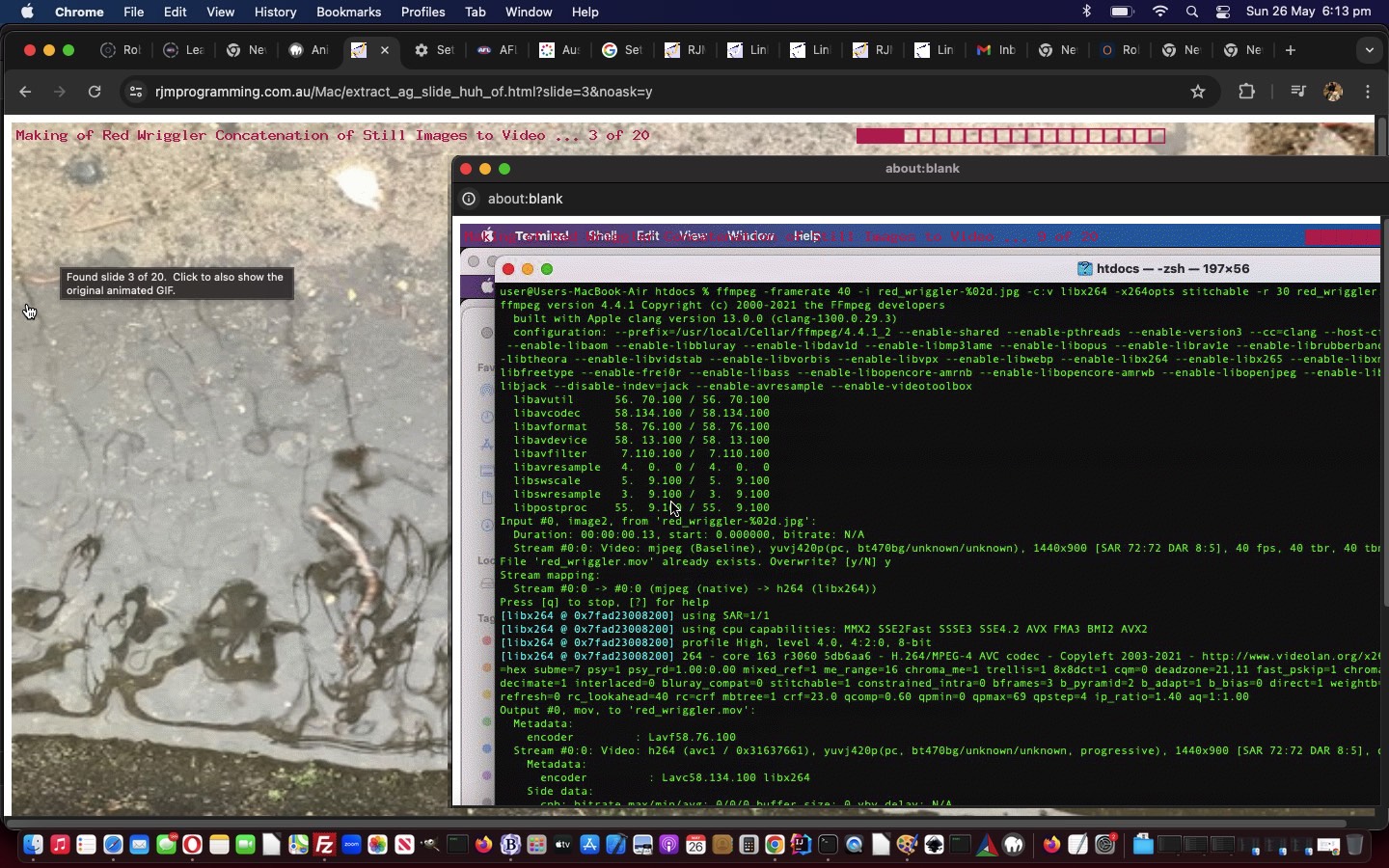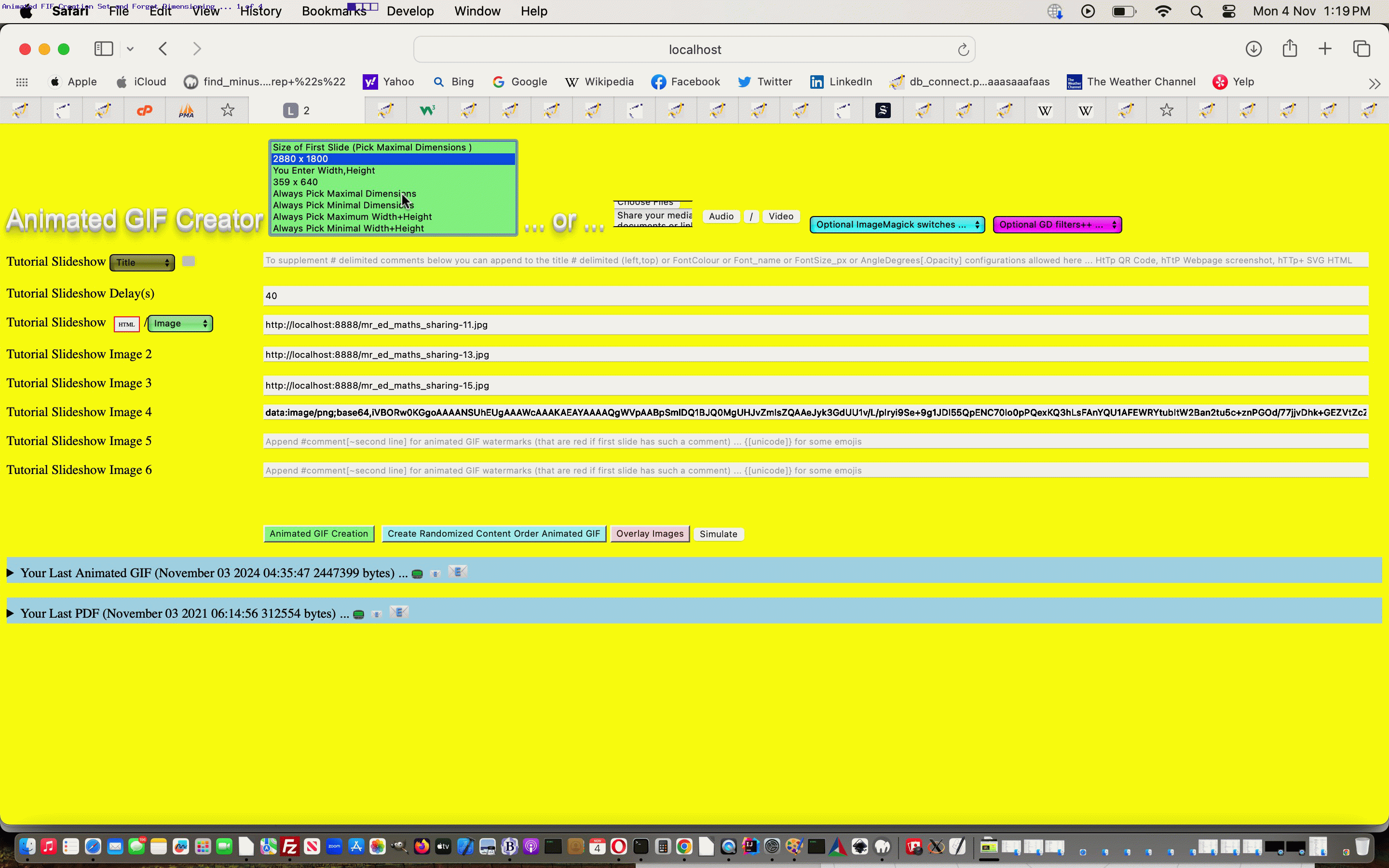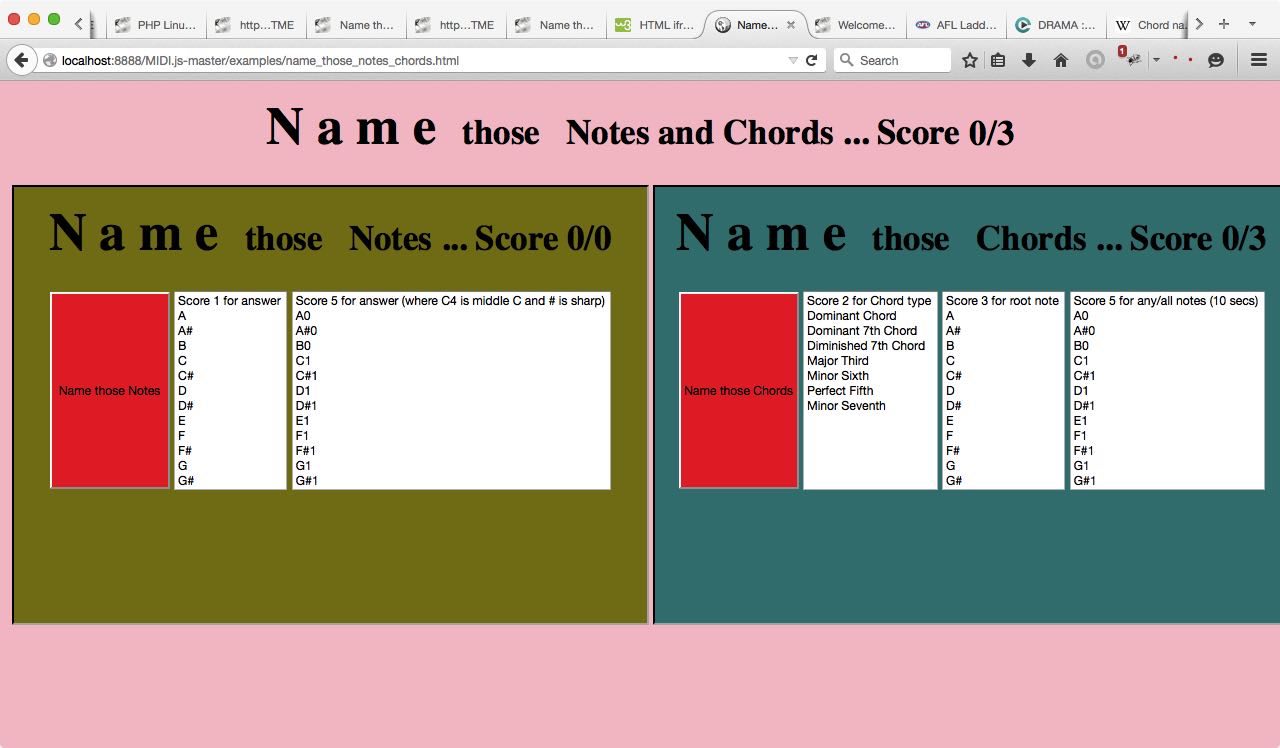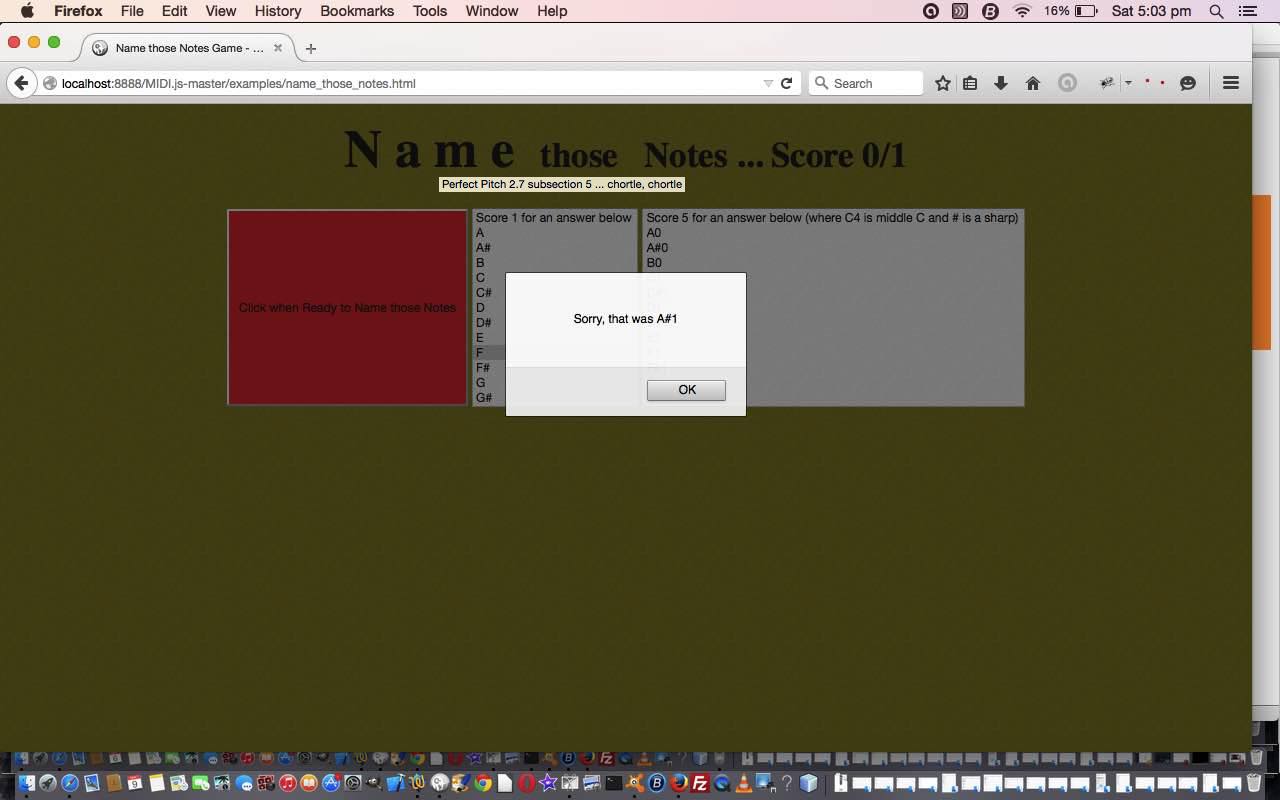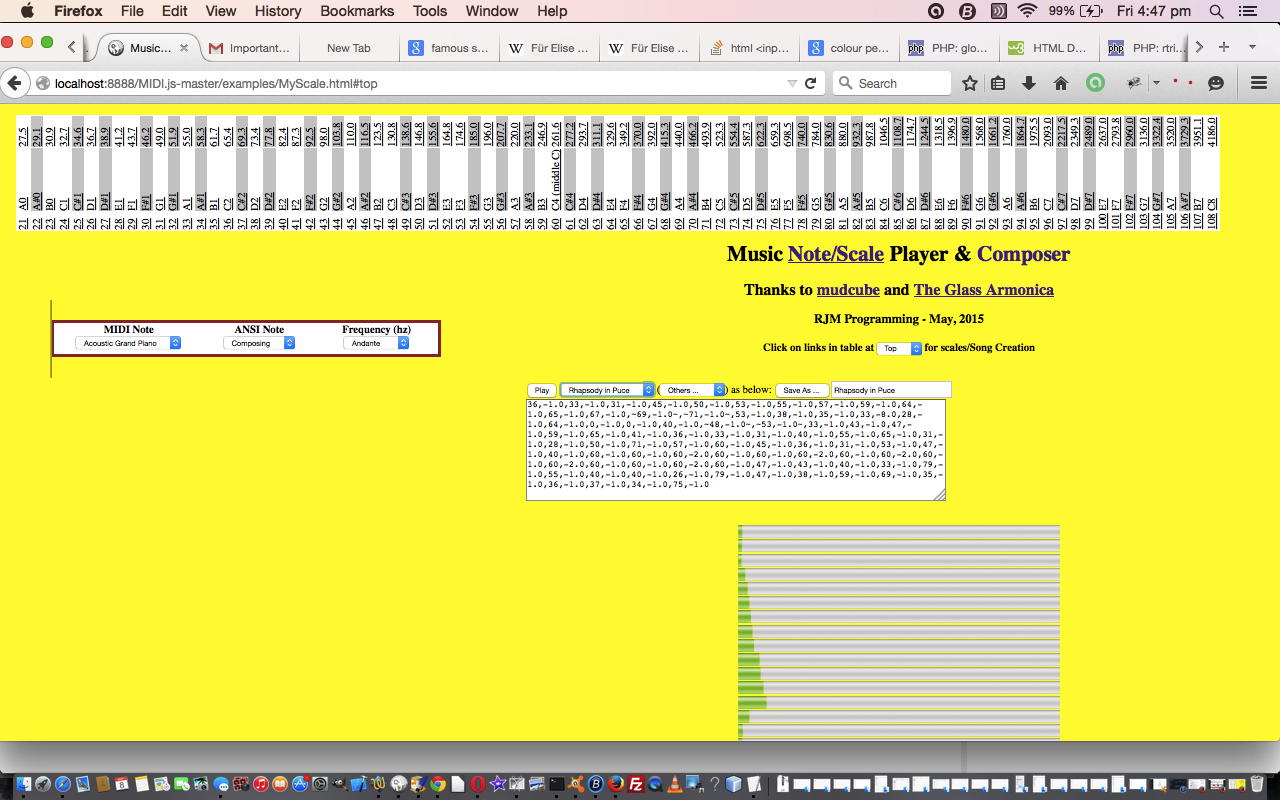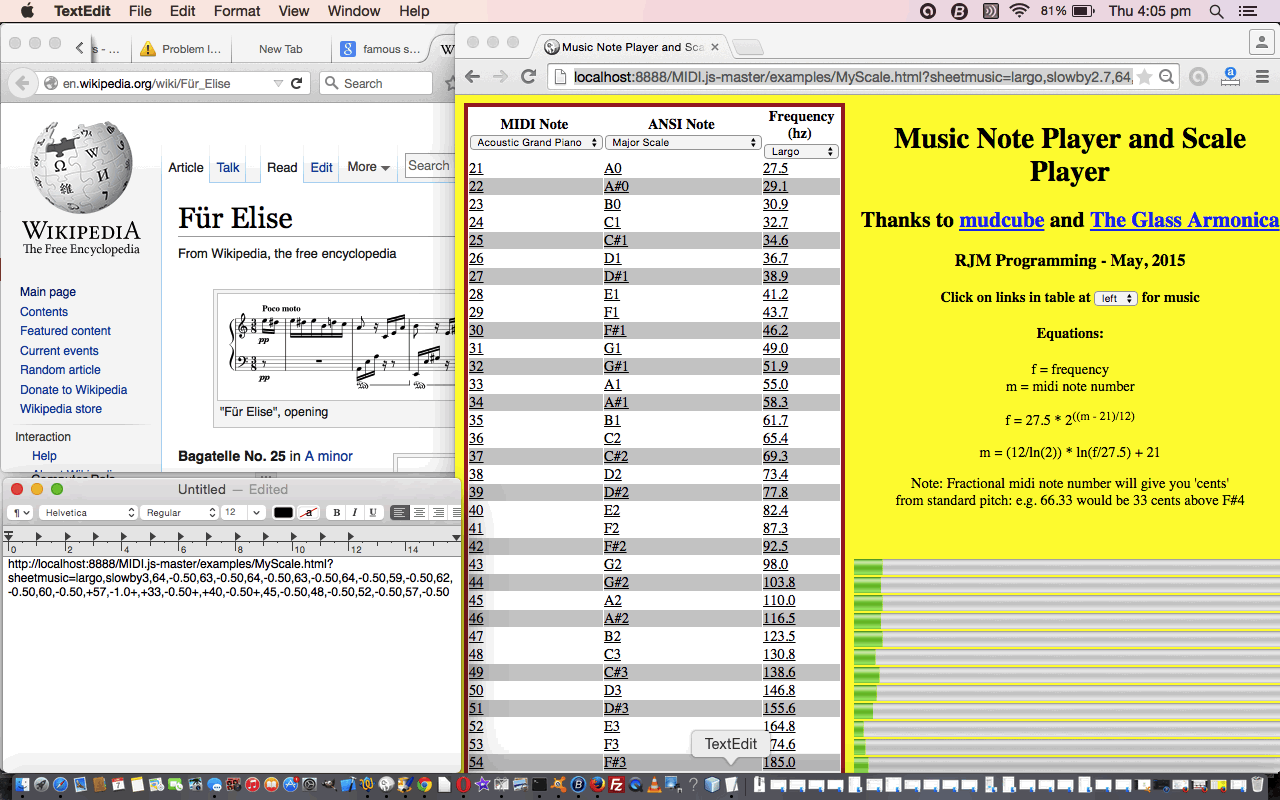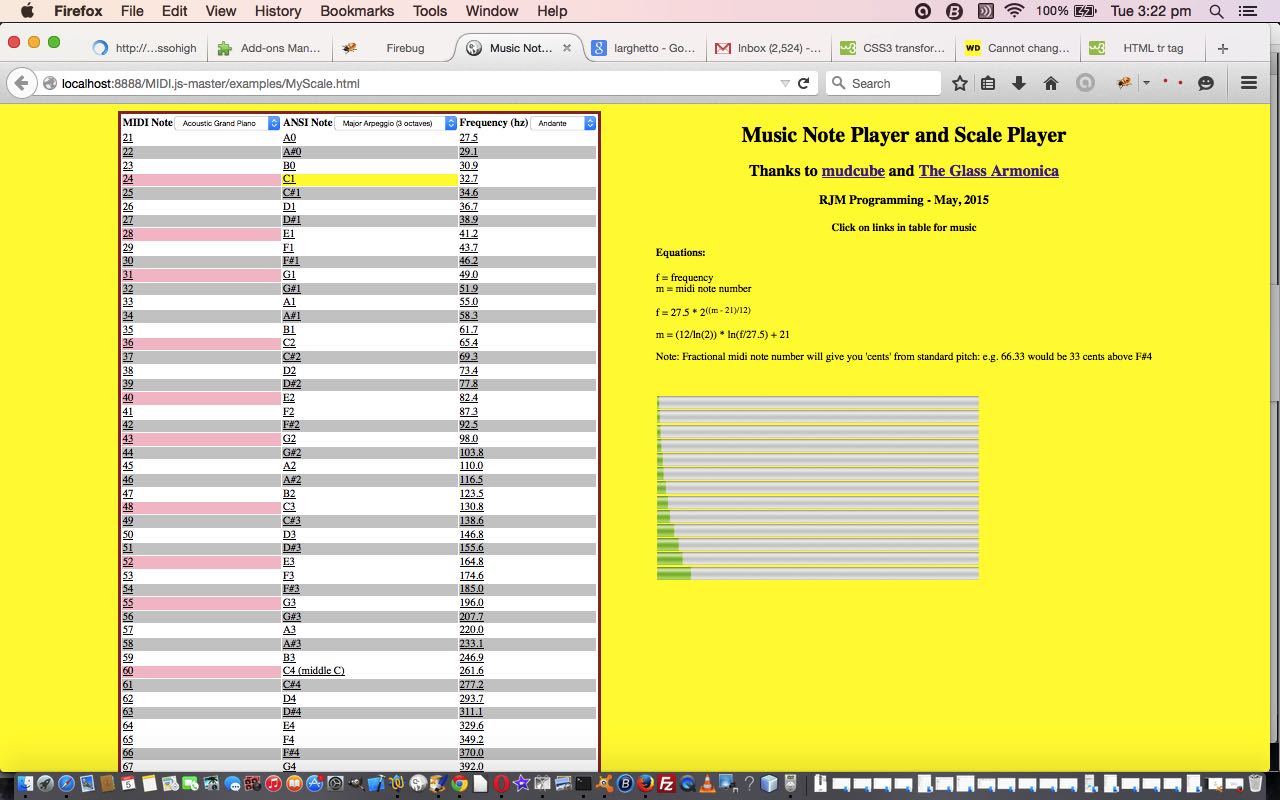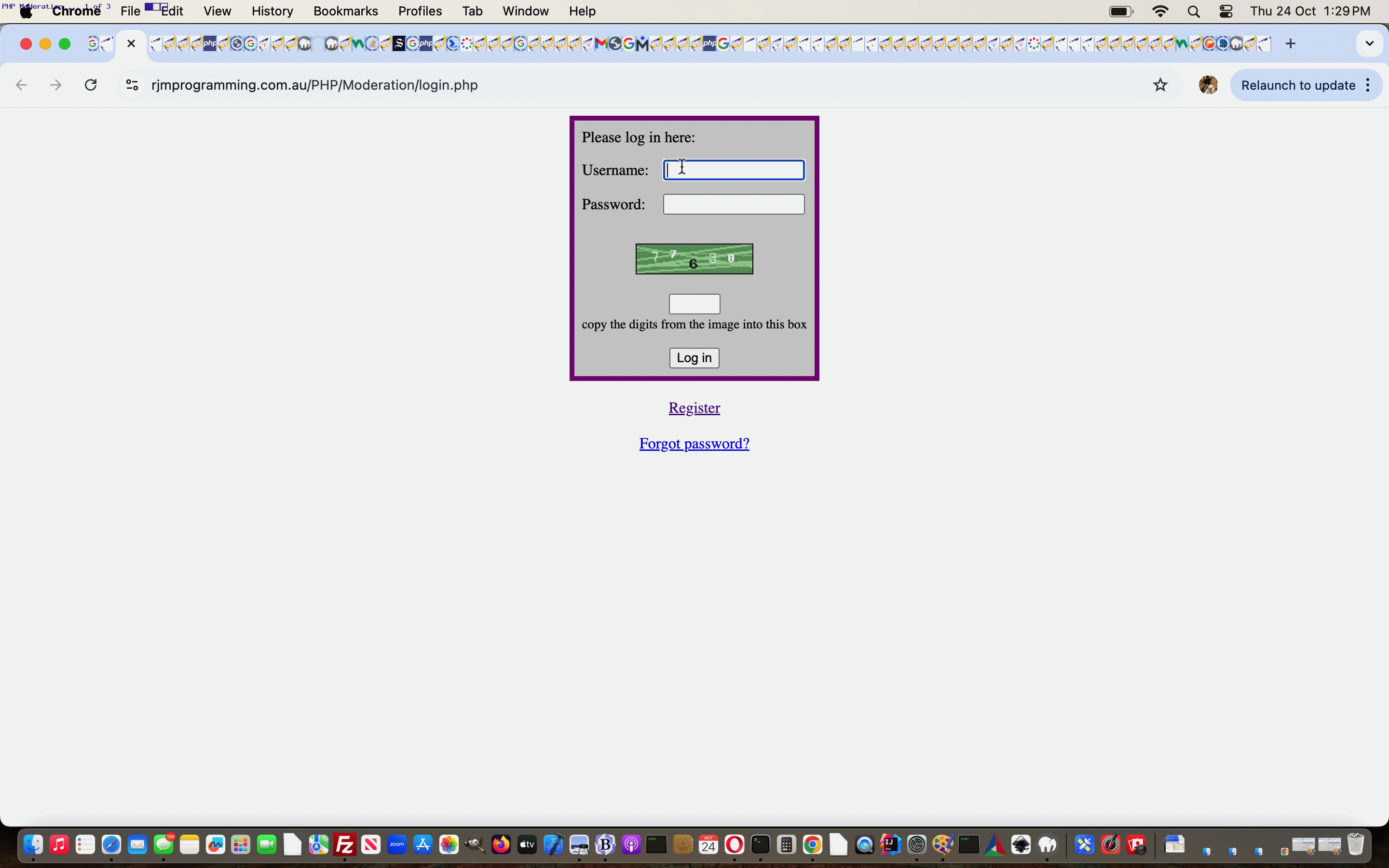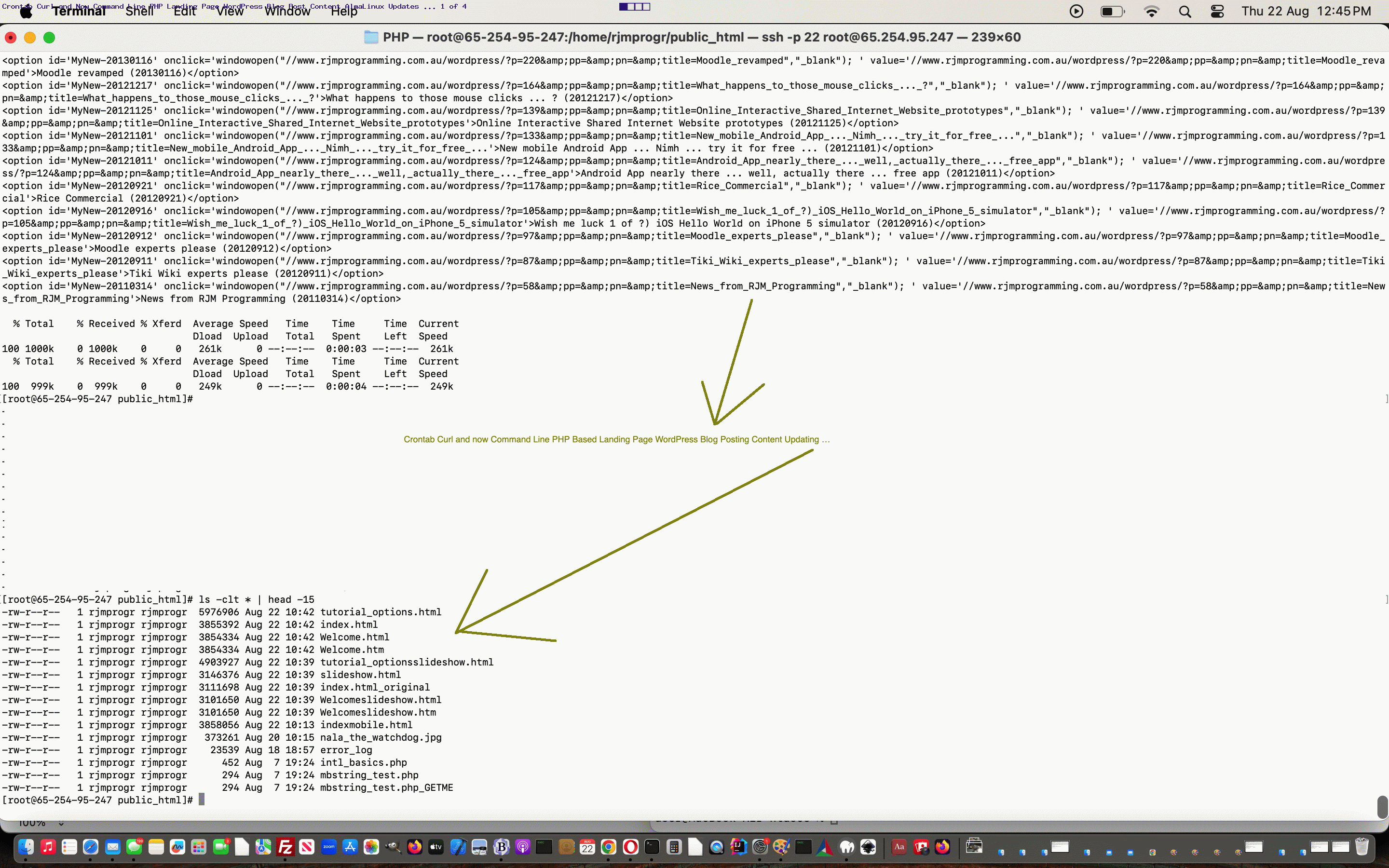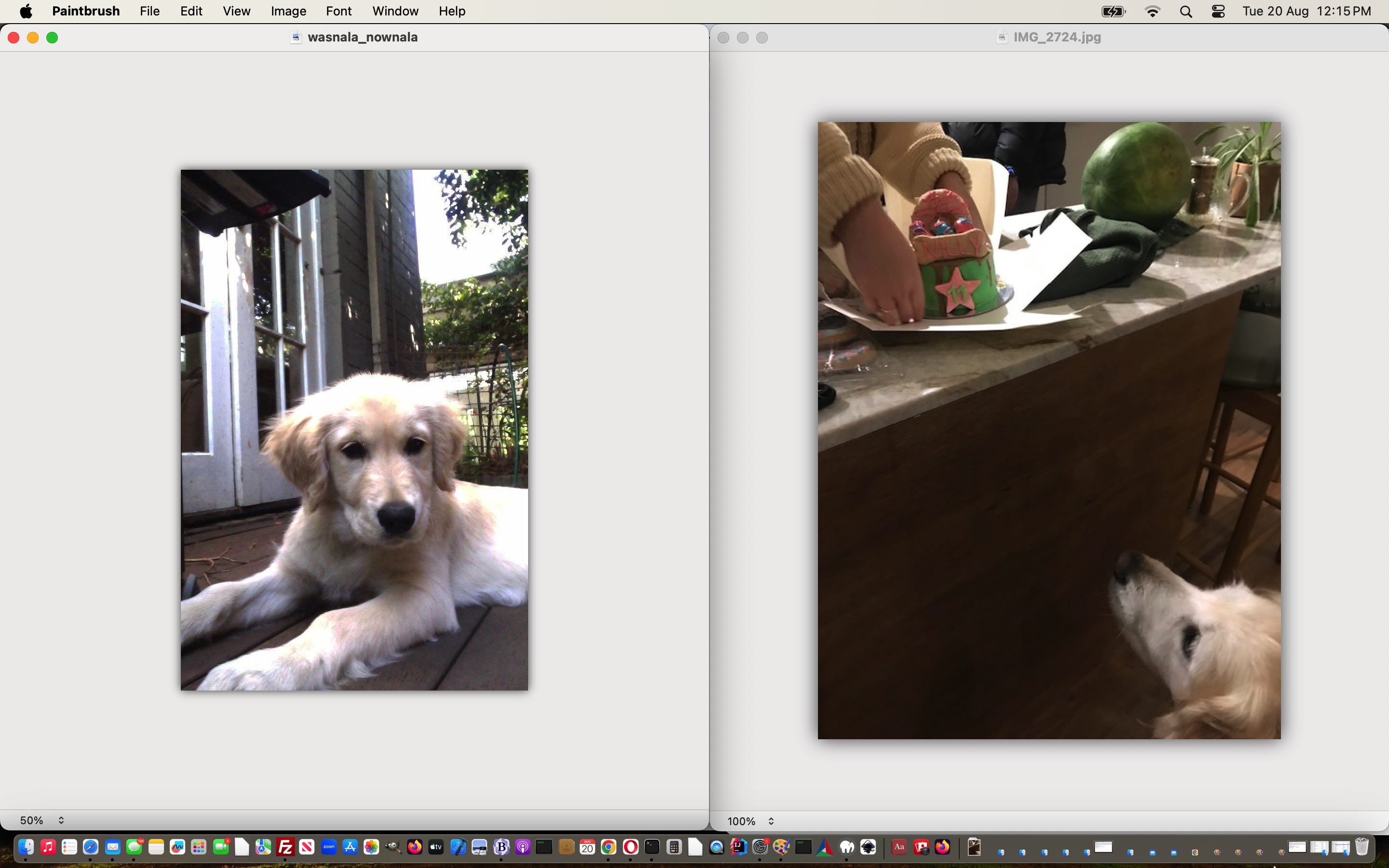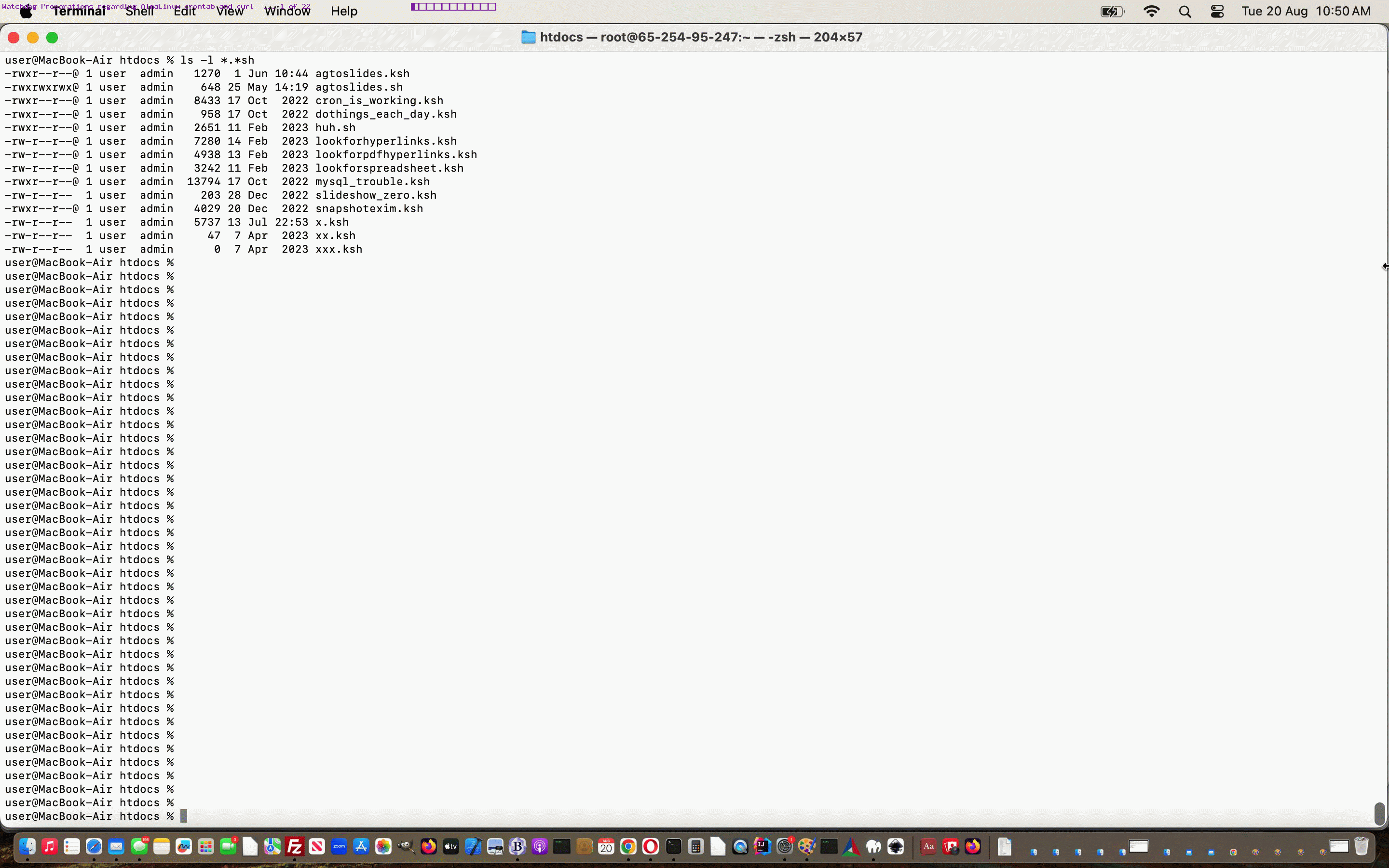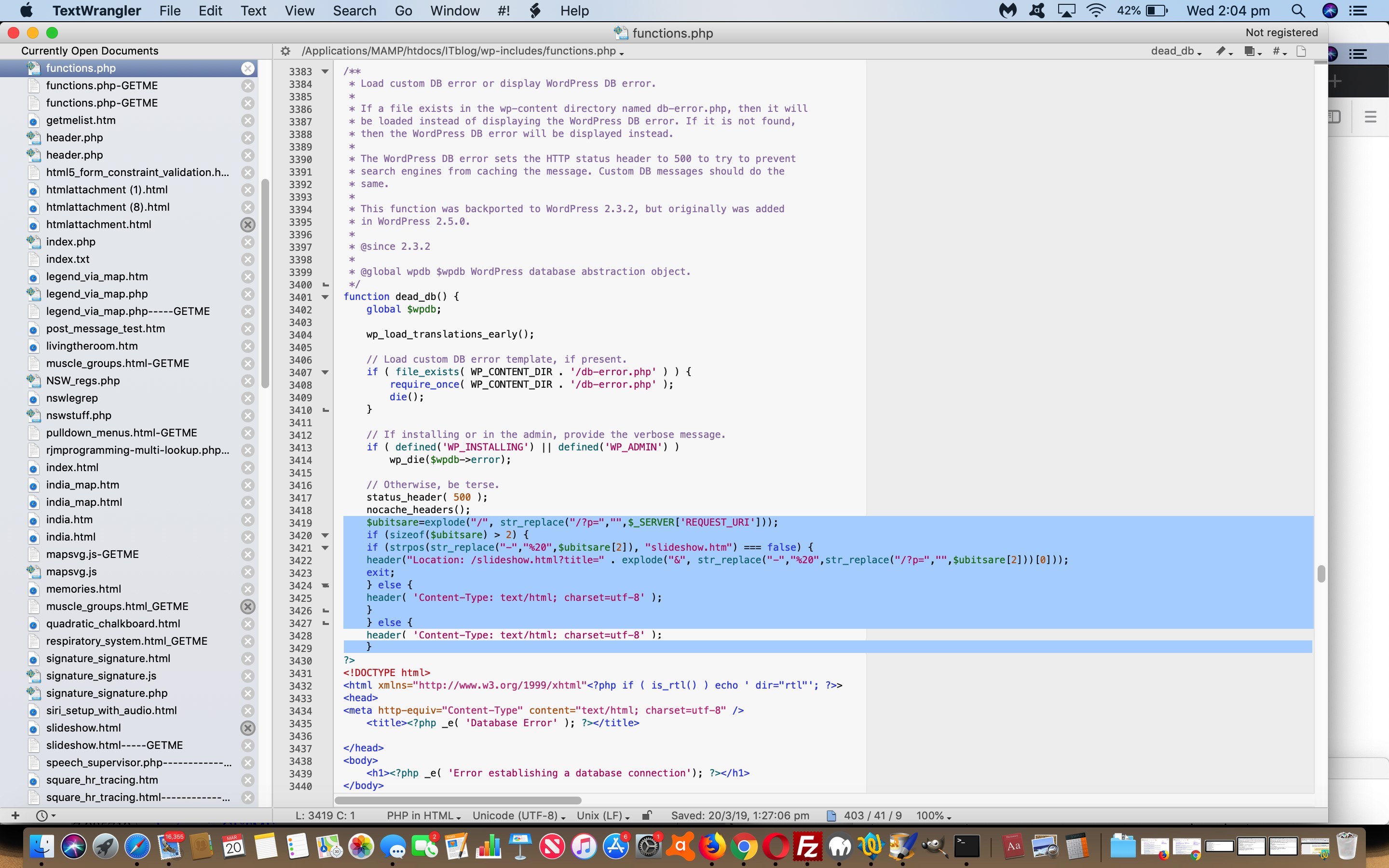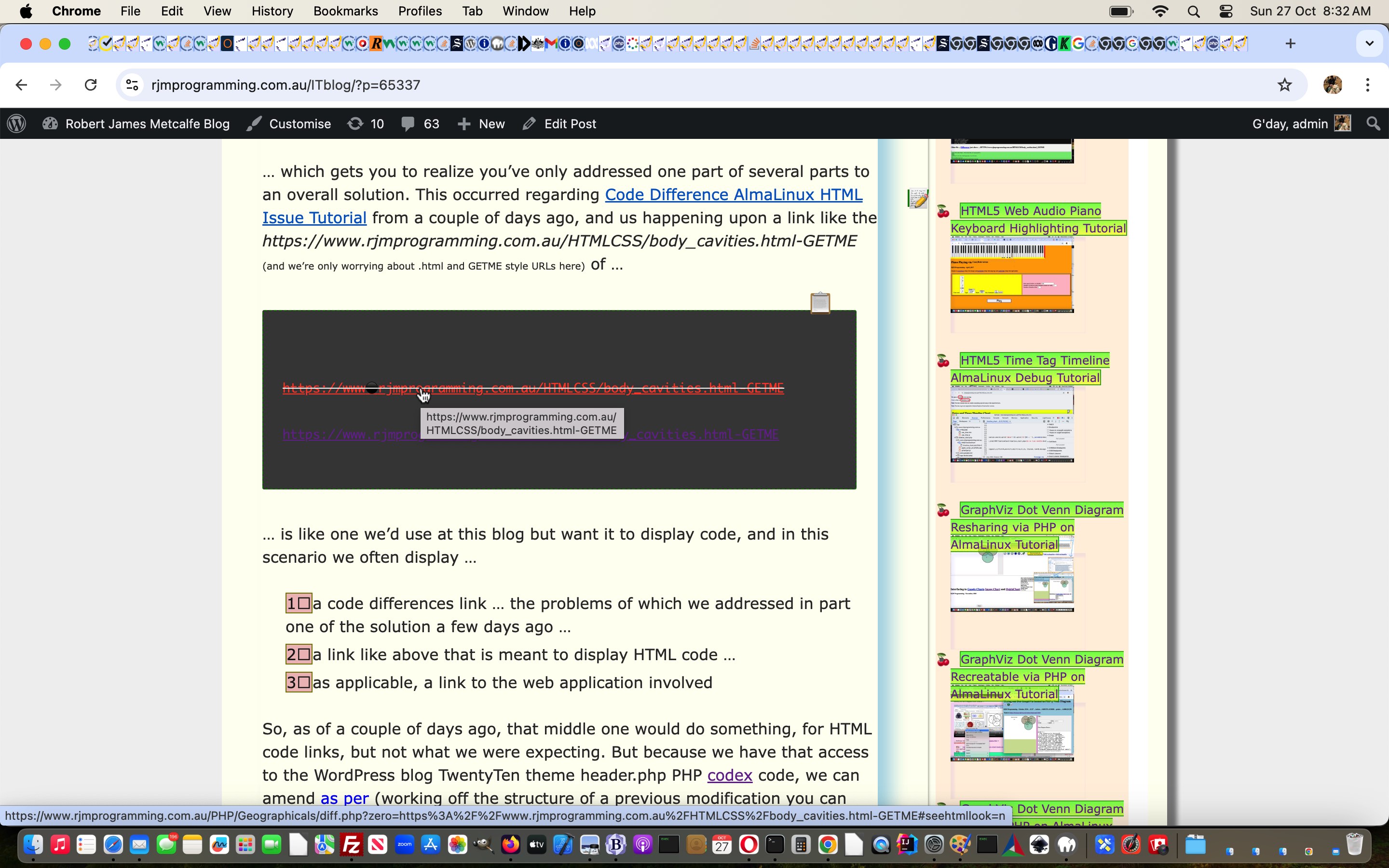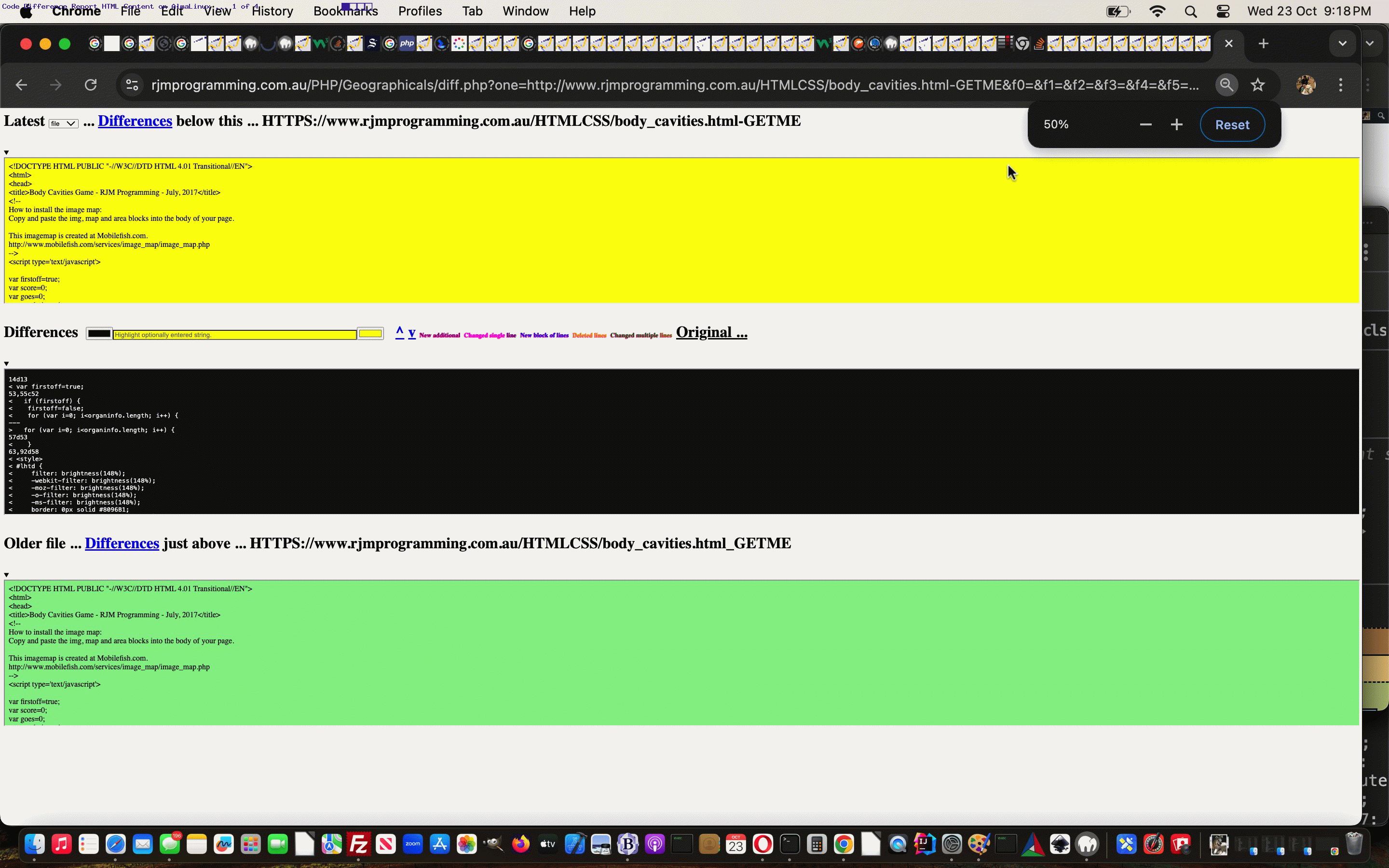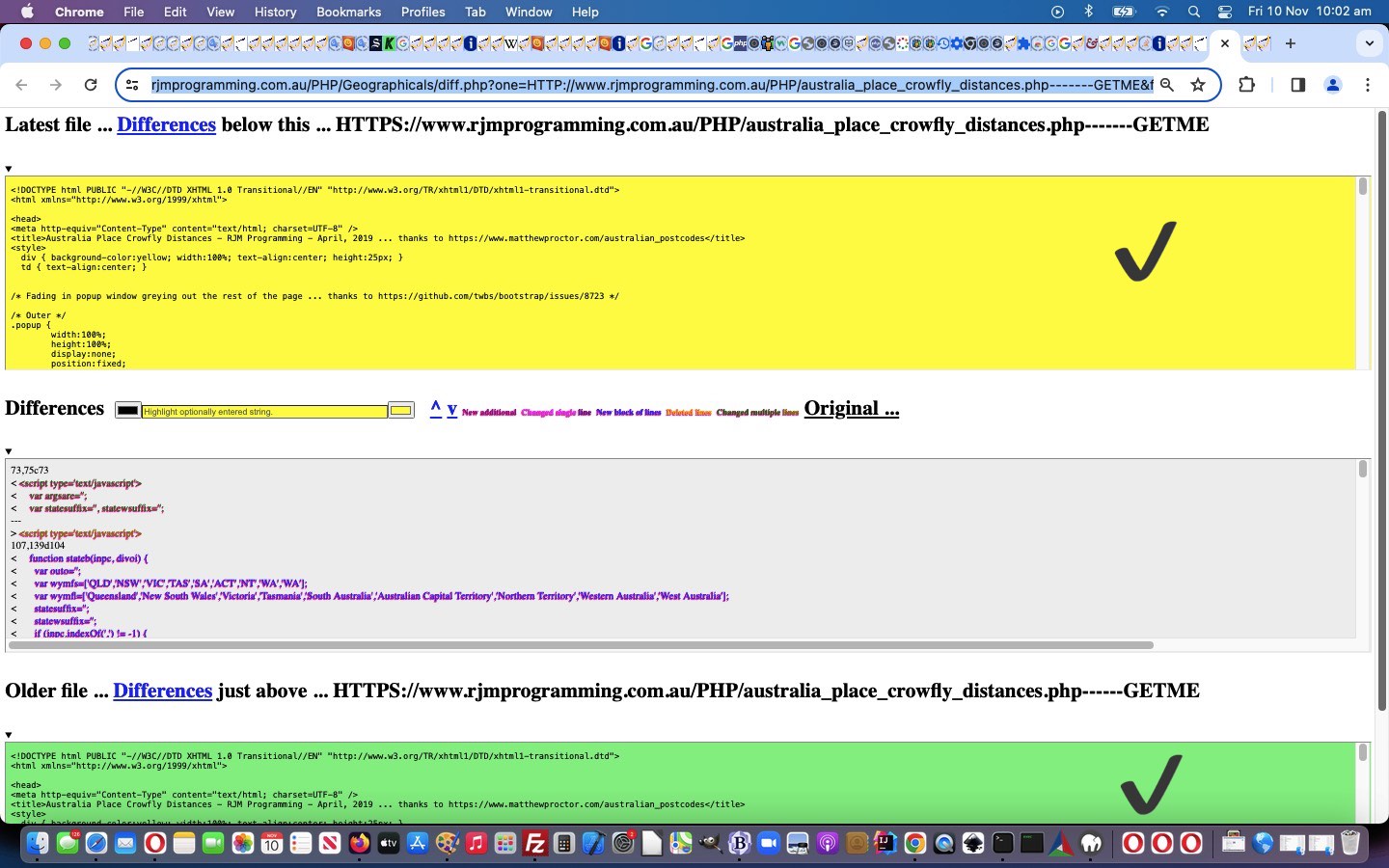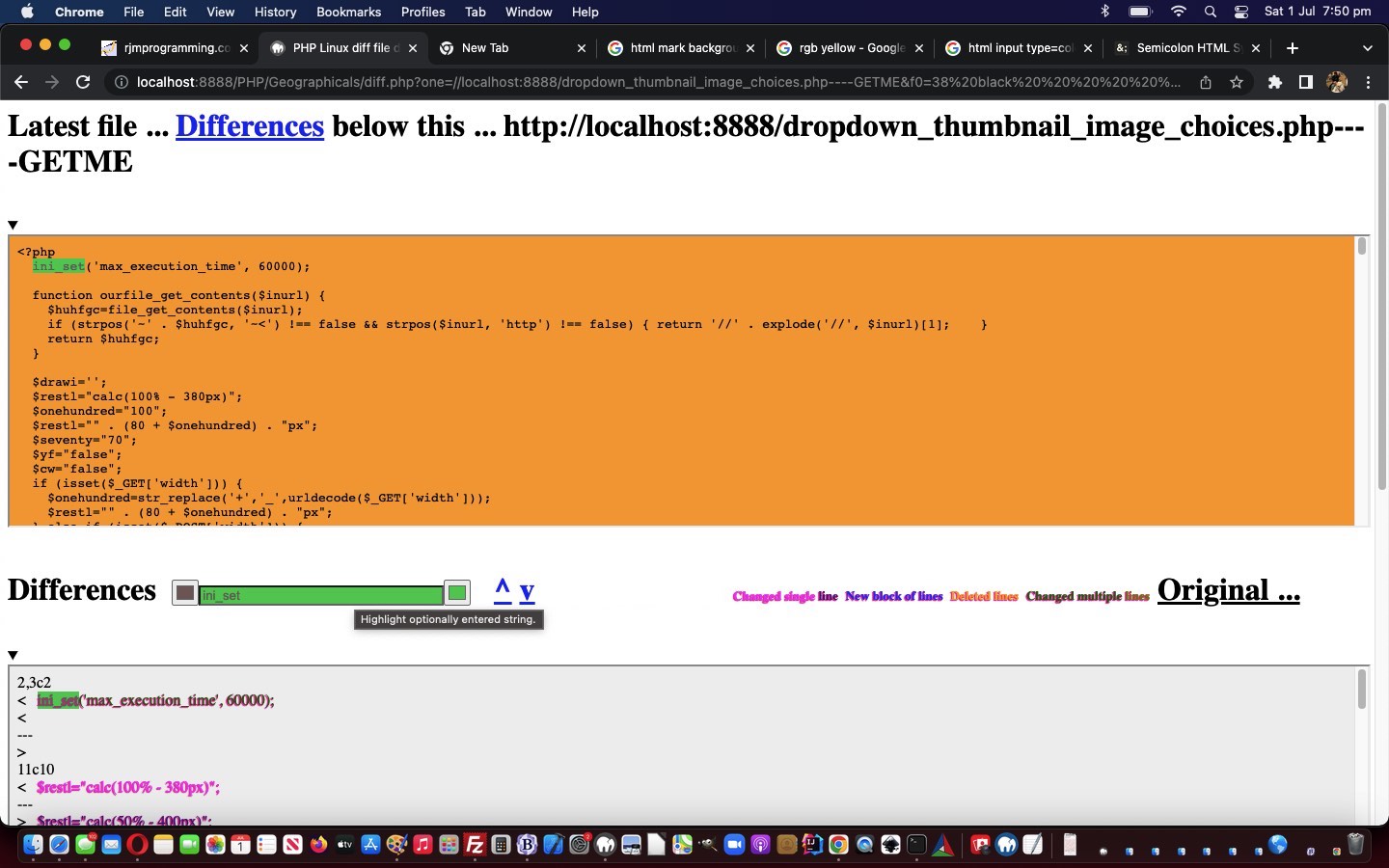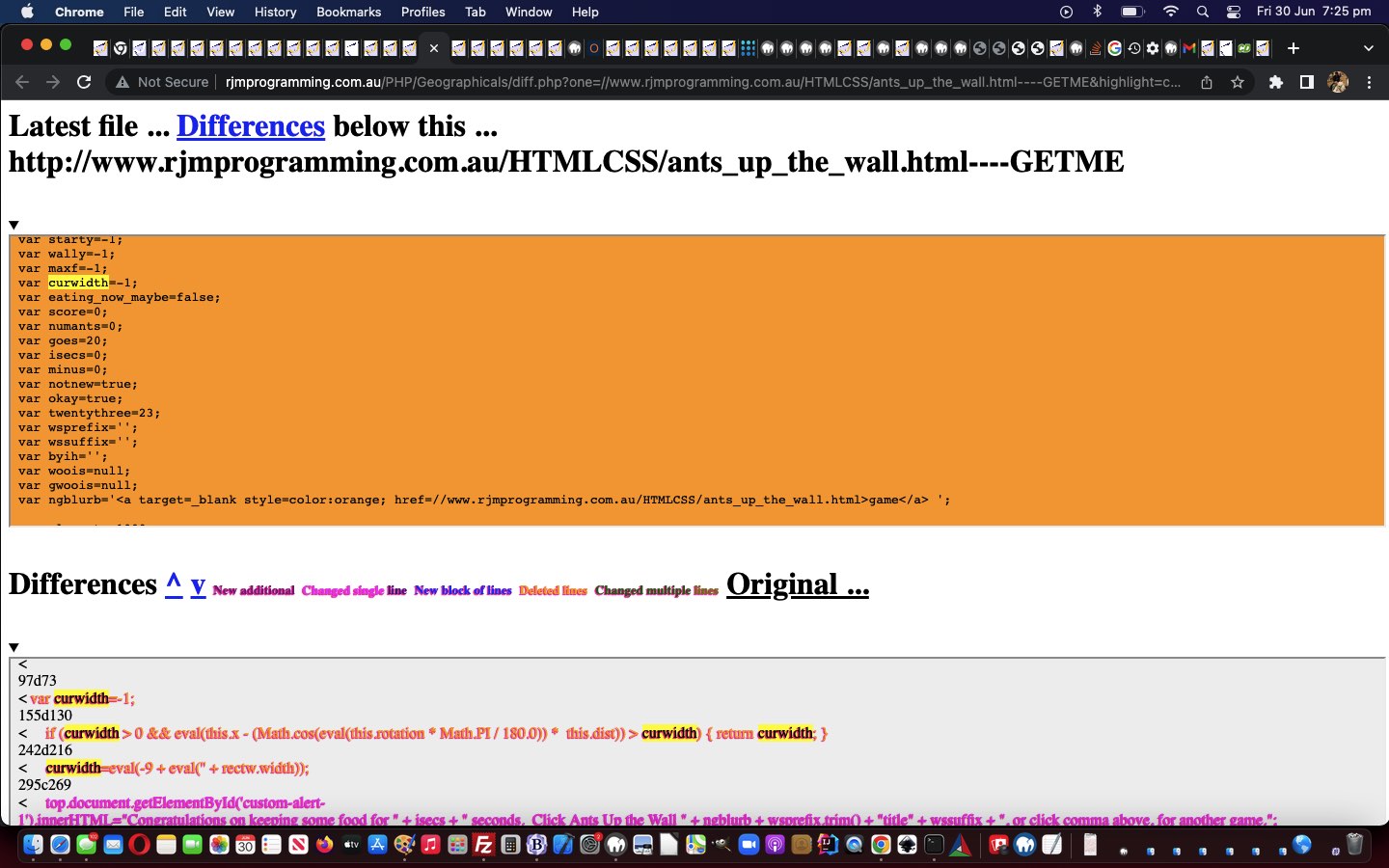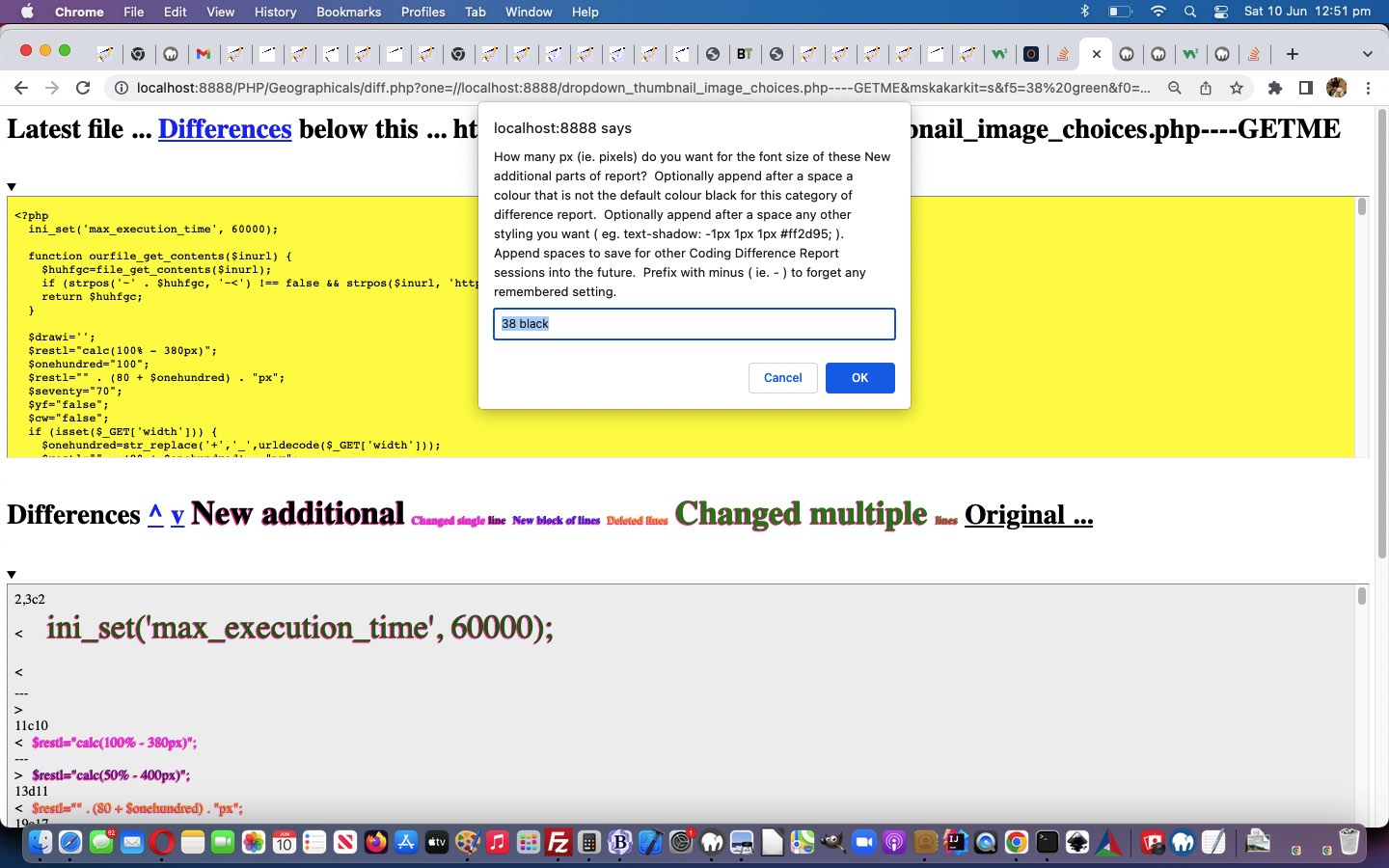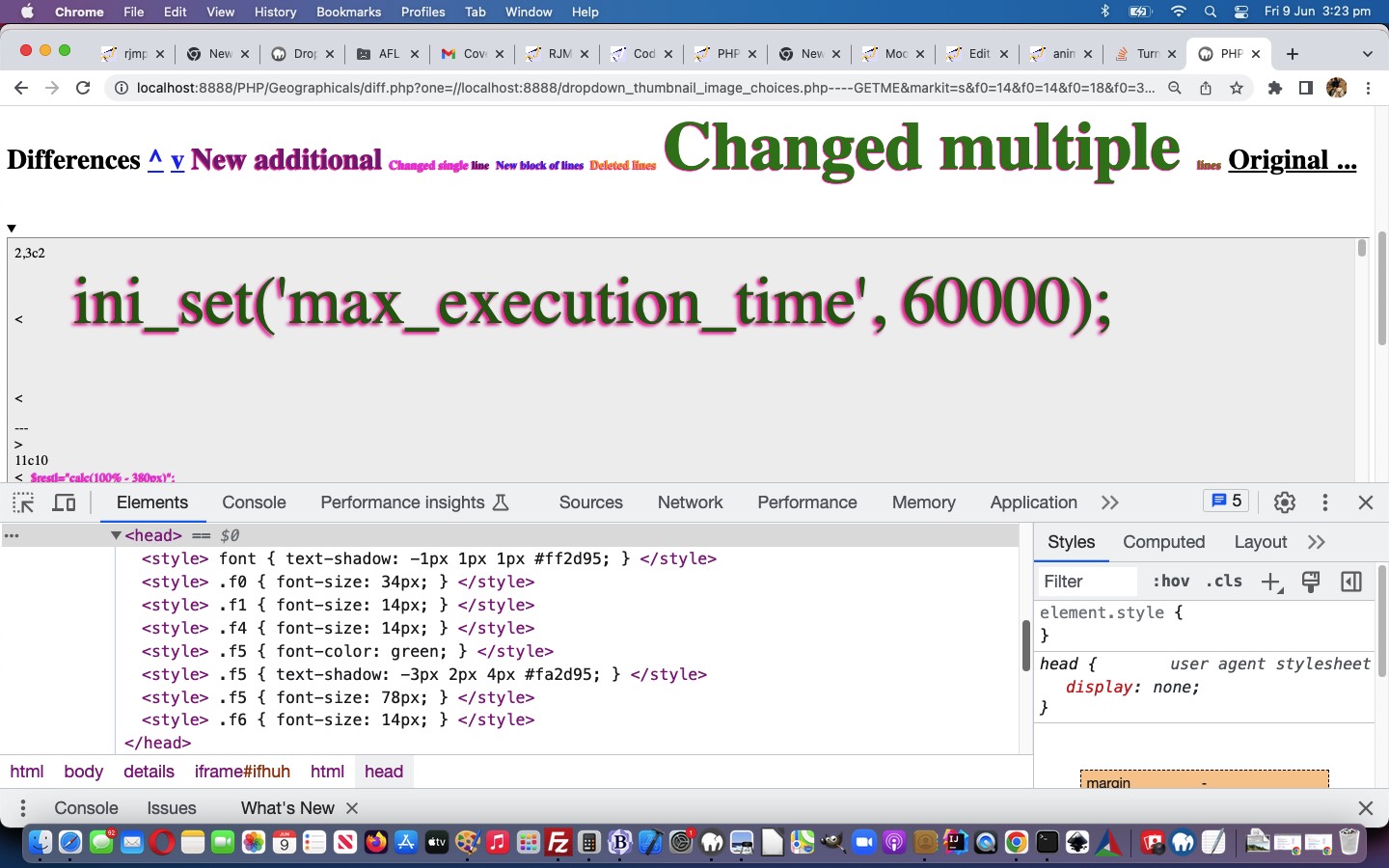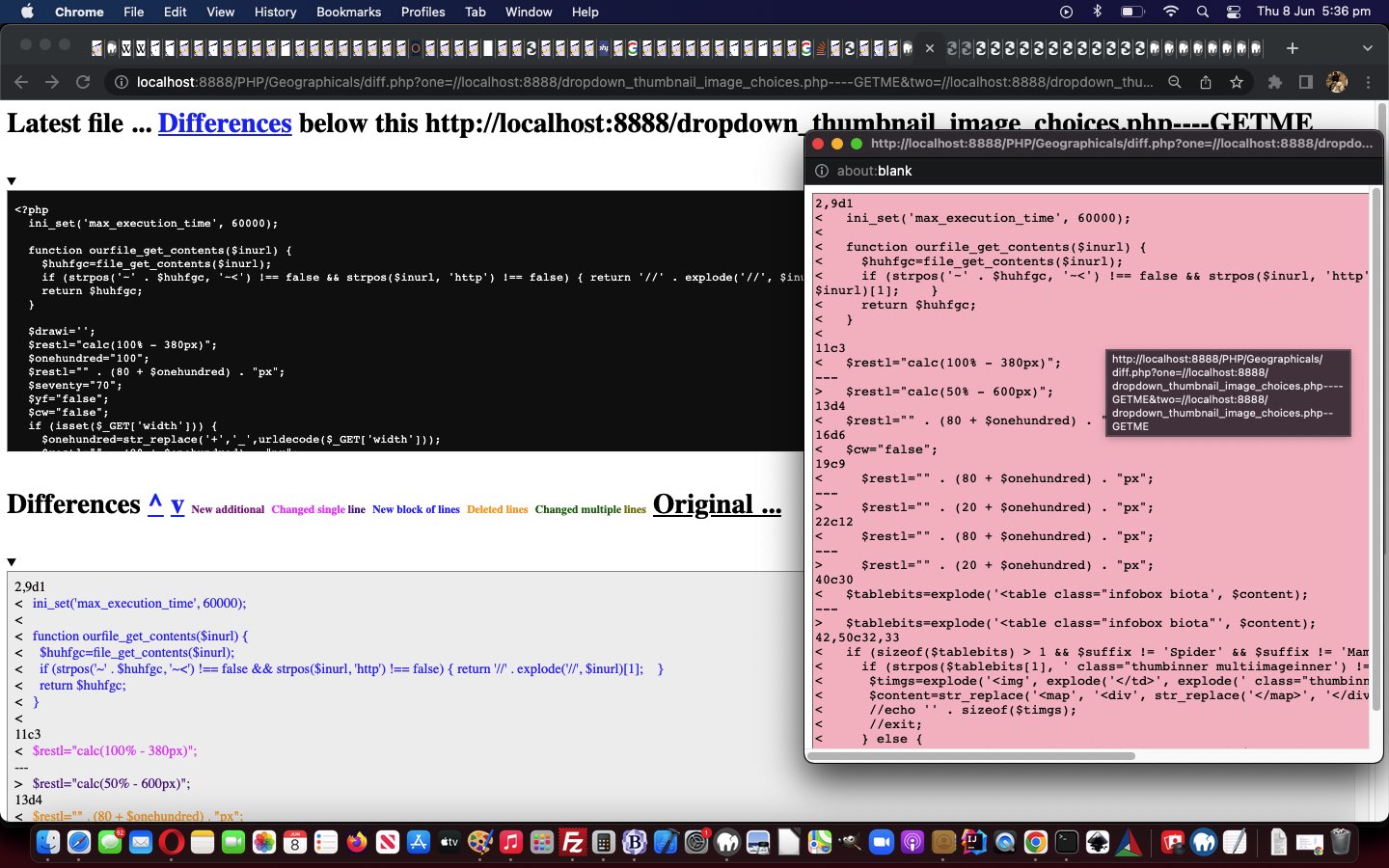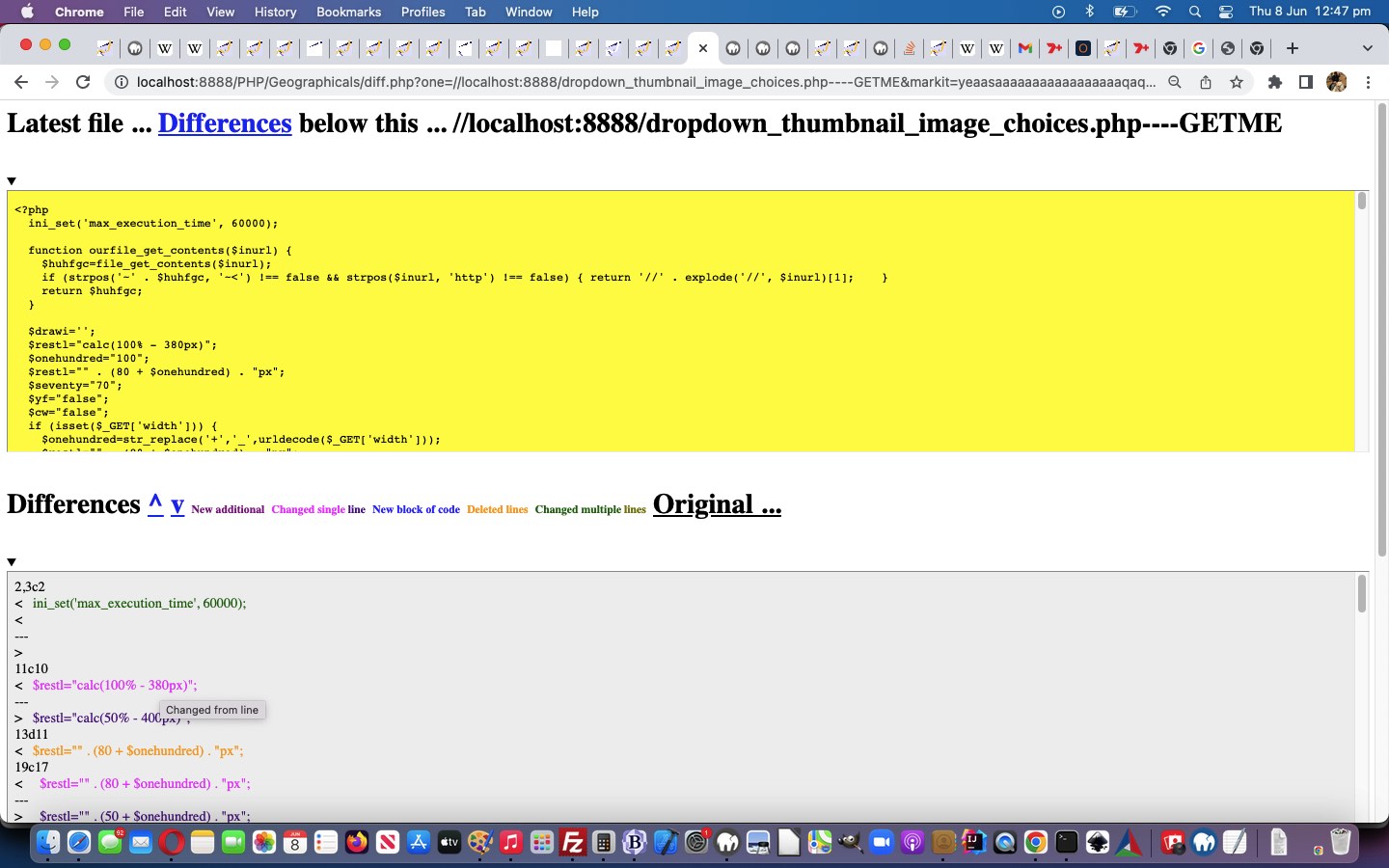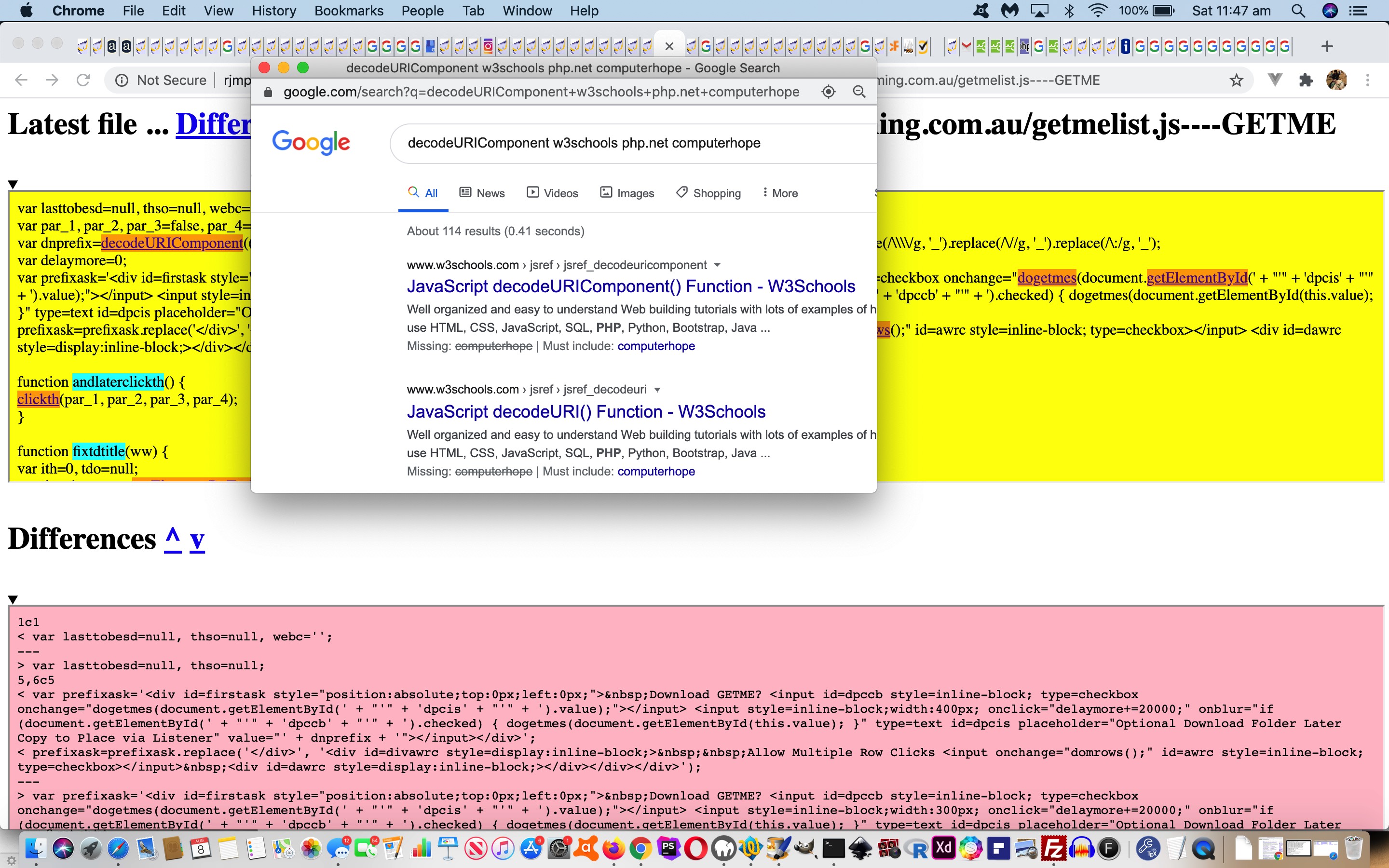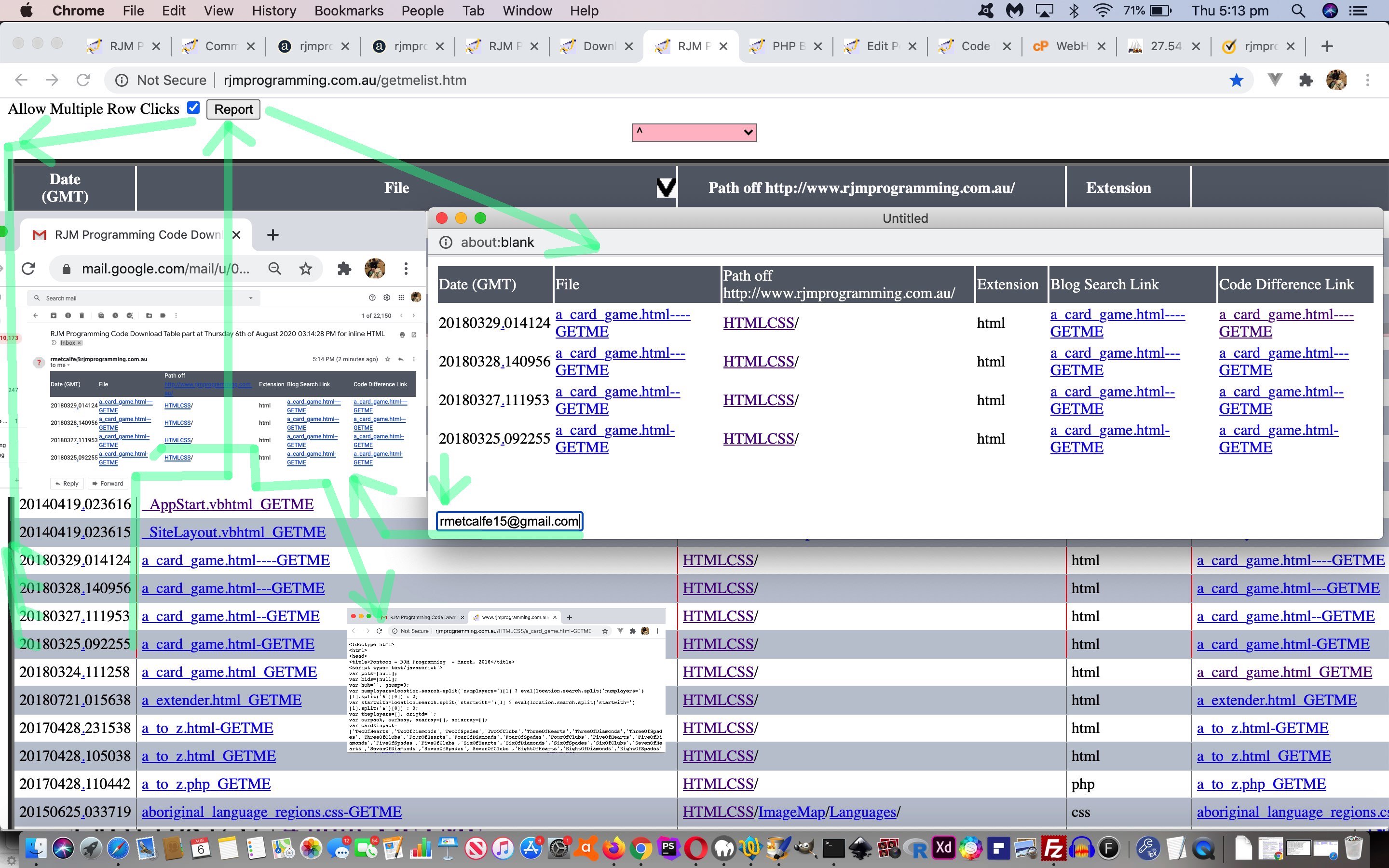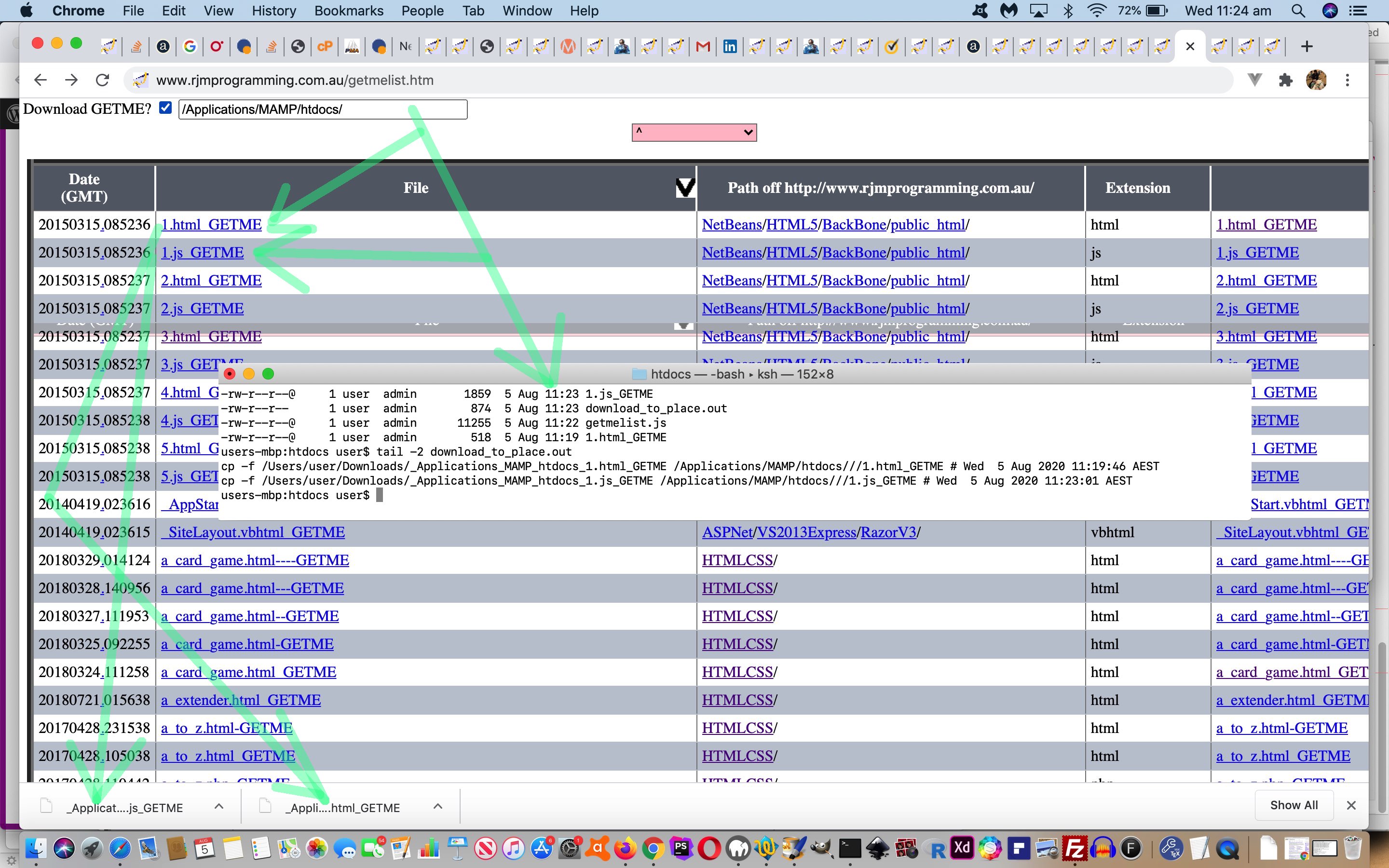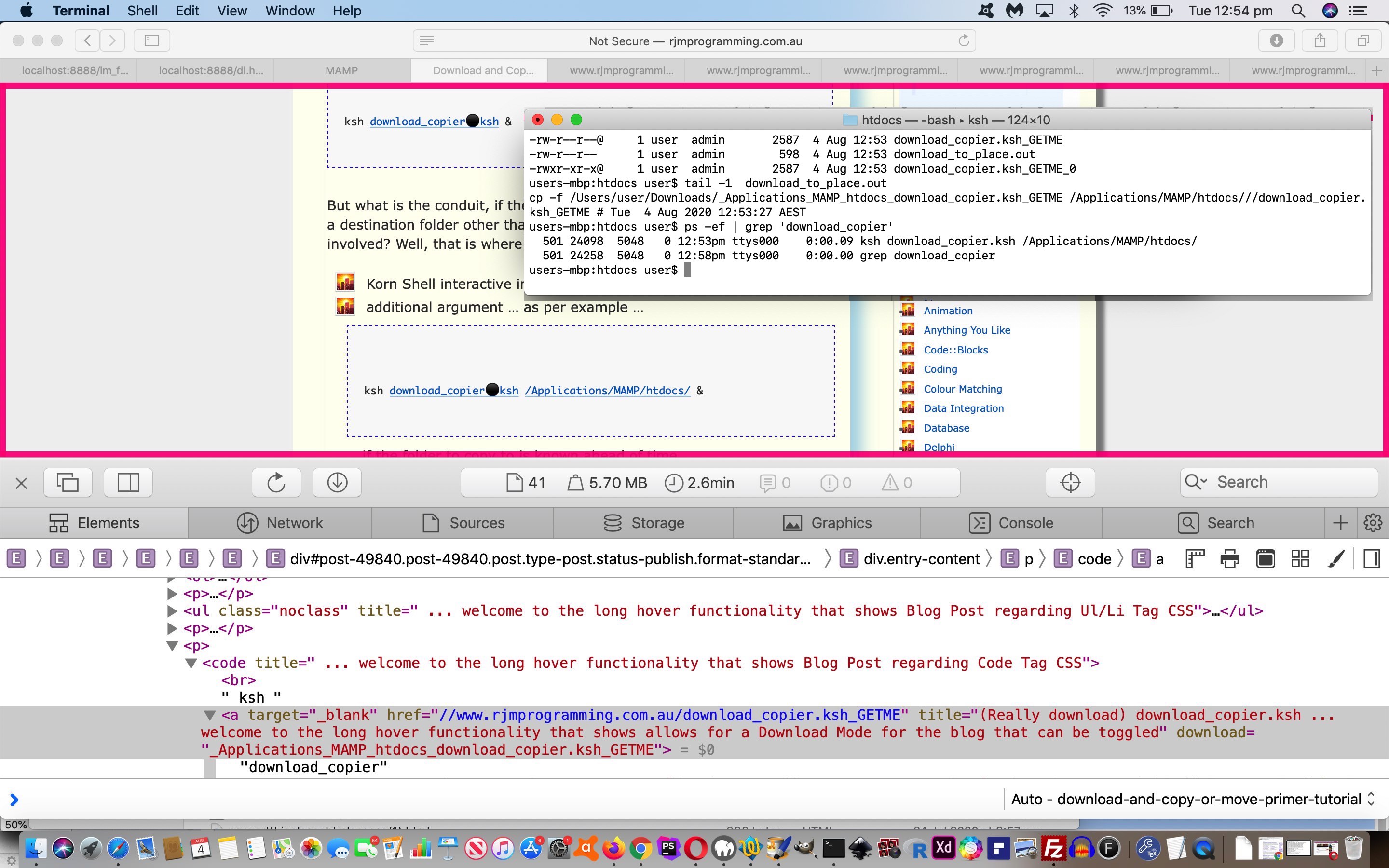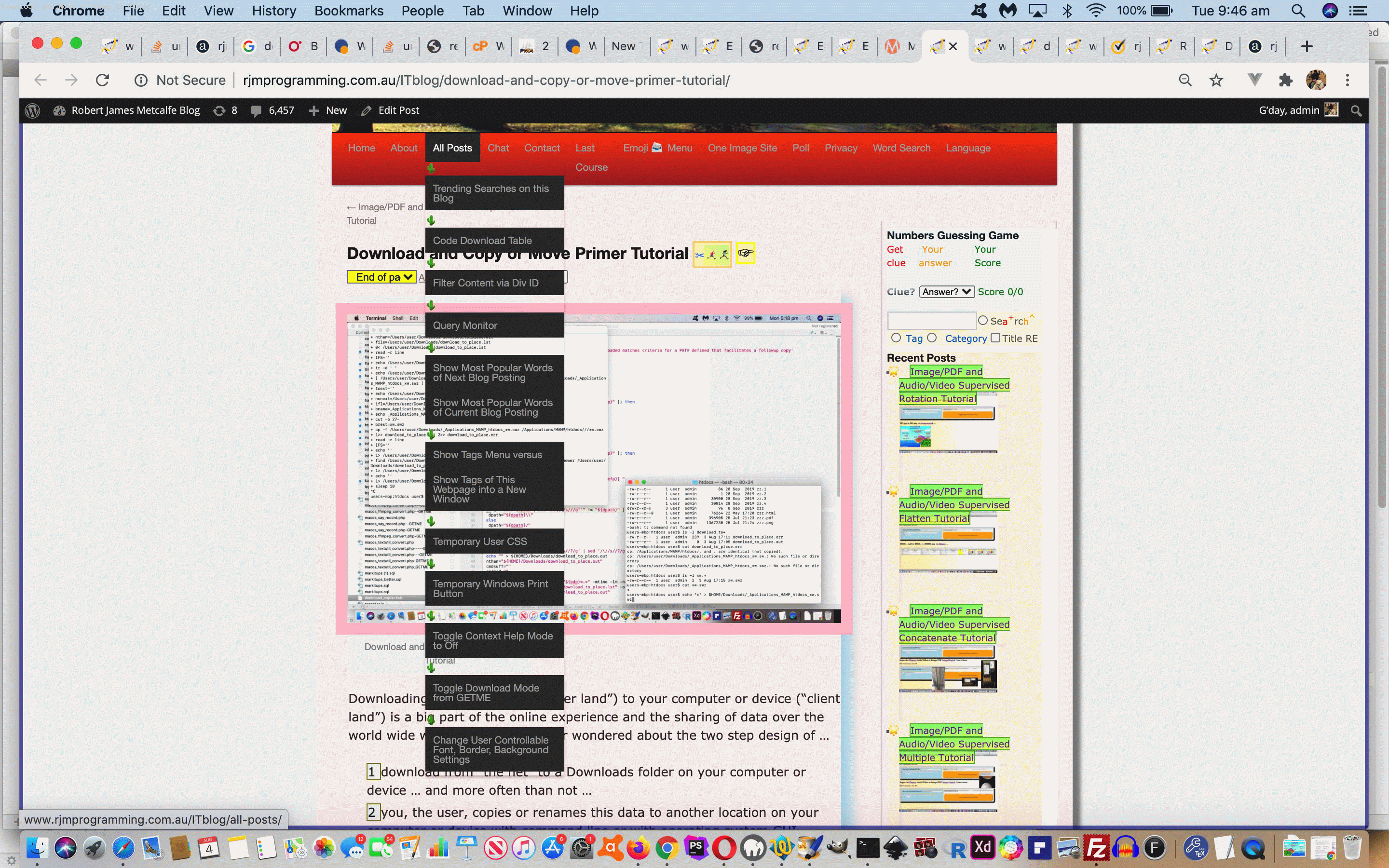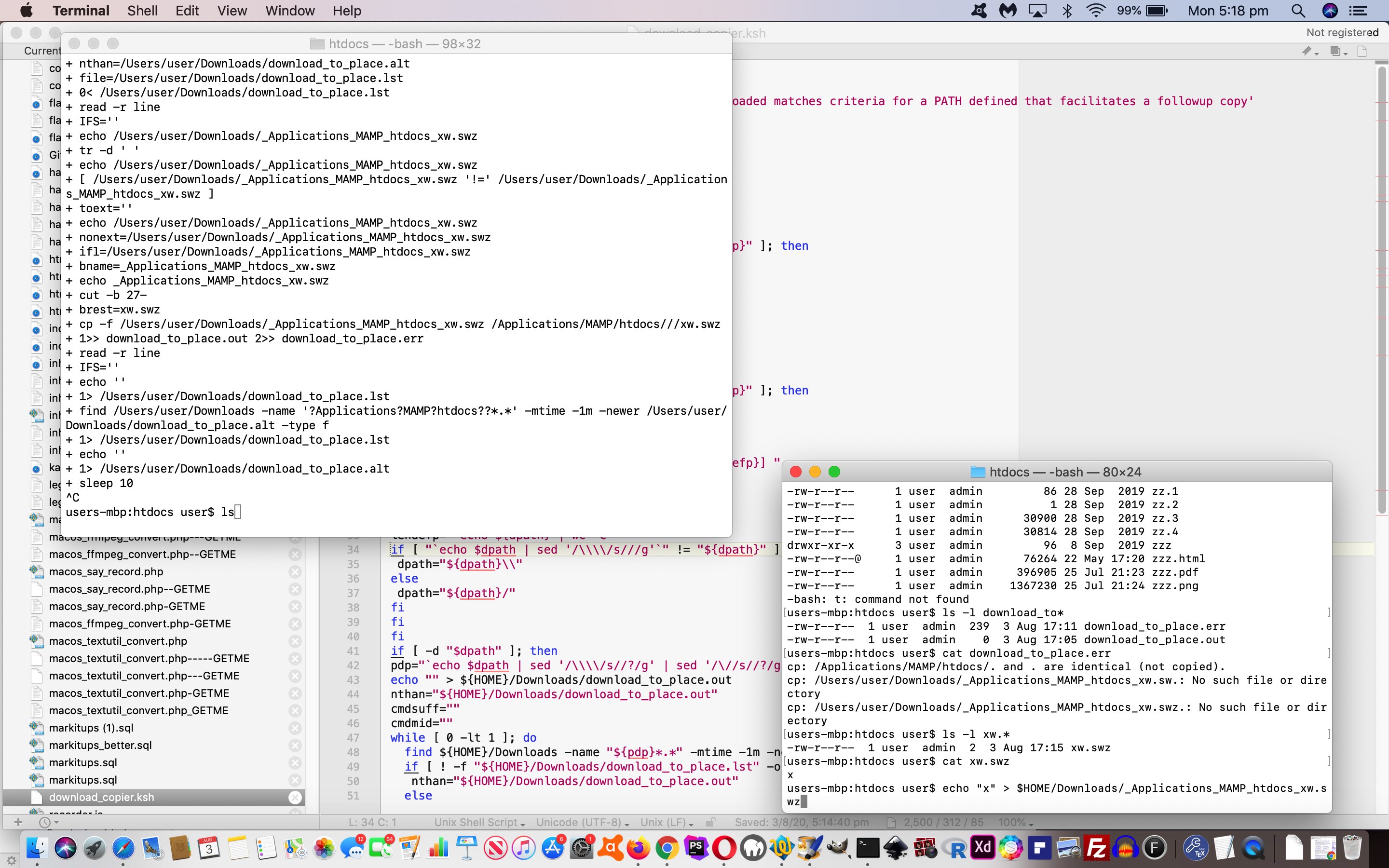Further to yesterday’s Animated GIF Slide GIFEncoder AlmaLinux Tweaks Tutorial‘s inhouse Animated GIF Creator web application improvements, today we channel how with going from …
- CentOS Apache PHP version starting with a 5 … to …
- AlmaLinux Apache PHP version starting with an 8
… recently, we got the opportunity to install the great ffmpeg on our AlmaLinux web server, you might recall when we presented Ffmpeg Install and Public Face Tutorial, which means we can now offer Video creation … via …
<?php
if (strpos($_SERVER['SERVER_NAME'], 'rjmprogramming.com.au') !== false) {
if (!isset($_POST['video']) && isset($_POST['slideshow'])) {
$_POST['video']='y';
} else if (!isset($_GET['video']) && isset($_GET['slideshow'])) {
$_GET['video']='y';
}
}
?>
… alongside Animated GIF creation with this web application, when it is performed on our AlmaLinux web server in the video enabled PHP tutorial_to_animated_gif.php inhouse animated GIF (and now video) creator web application.
Previous relevant Animated GIF Slide GIFEncoder AlmaLinux Tweaks Tutorial is shown below.
Around here, we’re so used to using PHP local web server Apache/PHP/MySql MAMP (for PHP version starting with a 7) for our Animated GIF creations, and we recommend the (downloading PHP code to a) local web server approach here (but read on), that we forgot to suss out whether there were any issues with the brilliant László Zsidi GIFEncoder.class.php PHP class making it all happen.
Discombobulated we were to find there were issues going from …
- CentOS Apache PHP version starting with a 5 … to …
- AlmaLinux Apache PHP version starting with an 8
The major issue was that …
- curly brace PHP syntax, in a lot of data array index and string offset related guises, is deprecated in PHP8 … but still okay in PHP7 … (thanks to this great link for advice) …
- class constructors cannot use the Class name any more, but rather use __constructor as the function name in the PHP code (thanks to this great link for advice)
And so we feel obligated to share with you better for PHP8 GIFEncoder.class.php to go along with a curly brace tweaked PHP tutorial_to_animated_gif.php inhouse animated GIF creator web application you should have more success with, unless there is too much data, hosted on the RJM Programming domain.
Previous relevant Animated GIF Slide Extraction Applied CSS Styling Tutorial is shown below.
We dedicate today’s blog posting to the English phrase (that maybe works in other languages) …
… as it is about the pros and cons of HTML iframe integration, especially as it applies to CSS styling. Off the top of our heads we see a Pros and Cons table looking like …
| Pros and Cons of HTML Iframe Based Web Application Software Integration | |
|---|---|
| Pros | Cons |
| Become tools | Difficulty with styling integration especially regarding time of coding differences |
| Become modularised | Focus within iframe can cause problems |
| Ability to begin again at (0,0) regarding positioning | Hashtag navigation within iframe can cause problems |
| Sharing the coding and execution load | |
| Software organizational advantages | |
| Can glean information off parent and vice versa | |
| New chance for synchronizations | |
| Multitasking | |
| Coding language mixing | |
| Parent child interactions | |
… and, as you can see, we are mainly fans of what it can bring to the table (mild chuckle, followed by a chortle).
But that first Con can grate, that “Difficulty with styling integration especially regarding time of coding differences”, and today, we thought we’d “apply” to relevant (there was one we found we should not “apply” the thinking to) HTML iframe “child” styling using yesterday’s Animated GIF Slide Extraction CSS Styling Tutorial‘s CSS styling idea in the “parent” (“applied” to these children).
We used a “suck it and see” approach whereby we just, where applicable, appended the CSS <style></style> styling logic of yesterday (plus a bit) to the document.body “body” innerHTML attribute of the iframe called, to see whether it felt more integrated. And we thought it did, perhaps because that styling was one of the more generic feeling ones we can remember (by that we’re meaning that the selectors were often just HTML tag names rather than too much “class” or “id” aspects to those selectors). Also, sometimes it won’t work because adding to the document.body innerHTML can sometimes “muck up” logic (but not today).
And what allows for “deploying” such an idea? Inhouse, we call what we do here “Client Pre-emptive Iframe” ideas, where the relevant iframe element’s “onload” (or on rare occasions, “onerror”) events are used to add logic at a slightly later time to any HTML iframe document.body element’s “onload” logic would be applied. This is a powerful mechanism open to you if you are dealing with same domain parent/child URLs, that is the case for us with this work today.
It’s as easy to do as (showing you one iframe “onload” function example below, and with inline CSS usage, rather than an external CSS file usage (where it would be even easier)) …
var paconto=null;
function pcheckit(iois) {
paconto = (iois.contentWindow || iois.contentDocument);
if (paconto != null) {
if (paconto.document) { paconto = paconto.document; }
if (paconto.body != null) {
setTimeout(function(){
if (document.getElementById('pmyifthree')) {
document.getElementById('pmyifthree').scrolling='no';
}
document.getElementById('myifthree').scrolling='no';
paconto.body.innerHTML+='<st' + 'yle> ' + document.head.innerHTML.split('<st' + 'yle>')[1].split('</st' + 'yle>')[0] + ' </st' + 'yle>';
paconto.getElementsByTagName('select')[0].style.display='none';
paconto.getElementById('image').style.display='none';
paconto.getElementById('isub').style.display='none';
paconto.getElementsByTagName('div')[0].style.opacity='0.0';
paconto.getElementsByTagName('select')[1].style.display='none';
paconto.getElementsByTagName('h1')[0].style.opacity='0.0';
if (1 == 1) { paconto.getElementsByTagName('h4')[0].style.opacity='0.0'; }
if (1 == 1) { paconto.getElementsByTagName('h3')[0].style.opacity='0.0'; }
}, 12000);
}
}
}
… to make this idea come, above. We don’t go overboard with precise integration, that is not our point. Just a …
Same, same but different
… feel in the changed tenth draft extract_ag_slide_huh_of.html Animated GIF Slide Extraction web application (or Animated GIF Slide Extraction via User Interaction web application version, or now, the Animated GIF Slide Extraction via User Interaction web application hashtag speed test version), which you can try below.
Previous relevant Animated GIF Slide Extraction CSS Styling Tutorial is shown below.
Another aesthetic plus on top of …
- user experience improvements … can be …
- CSS styling
… which we flesh out more of today, further to yesterday’s Animated GIF Slide Extraction Speed Test Tutorial.
What was new to us with today’s work? The linear gradient effect (called text gradient) applied to text was new, thanks, in amongst …
<style>
#agmode { background-color: #98FB98; }
#agmodetwo { background-color: #AFEEEE; }
hr {
border: 5px solid green;
border-radius: 5px;
}
hr.one {
border: 5px solid red;
border-radius: 5px;
}
hr.two {
border: 5px solid orange;
border-radius: 5px;
}
hr.three {
border: 5px solid green;
border-radius: 5px;
}
body {
background: linear-gradient(to right, rgba(173,216,230,0.5) 0%, rgba(255,255,127,0.5) 100%);
}
img {
background: linear-gradient(to right, transparent 0%, transparent 100%);
border-radius: 9px;
}
h3 {
text-shadow: -1px 1px 1px #952dff;
}
input {
text-shadow: -0.4px 0.4px 0.4px #2d952d;
border-radius: 200px;
}
input::placeholder {
text-shadow: -1px 1px 1px #2d95ff;
}
summary {
text-shadow: -1px 1px 1px #ff952d;
}
h1 {
/* font-size: 72px; */
background: -webkit-linear-gradient(rgb(188, 12, 241), rgb(212, 64, 104), rgb(104, 212, 64));
-webkit-background-clip: text;
-webkit-text-fill-color: transparent;
}
iframe {
border-radius: 9px;
}
a {
border-radius: 9px;
}
</style>
… in the changed ninth draft extract_ag_slide_huh_of.html Animated GIF Slide Extraction web application (or Animated GIF Slide Extraction via User Interaction web application version, or now, the Animated GIF Slide Extraction via User Interaction web application hashtag speed test version), which you can try below.
Previous relevant Animated GIF Slide Extraction Speed Test Tutorial is shown below.
Yesterday’s Animated GIF Slide Extraction User Experience Tutorial sparked our interest in that …
- we wondered whether hashtag components appended to ($_GET) address bar URLs perhaps consisting of ? and & argument parts slowed things down … and after first considering some standalone arrangement …
- we realized we have quite good conditions with our current Animated GIF Extraction web application project predilections to adapt it
Getting into the coding of this we realized we were touching on another unknown to us. Is a hashtag call such as …
./agtoslides.php?slidenumber=1&random=56476858765876&delay=400&title=%2E%2Fuser_of_ss.gif&numfillin=3#agname=%2E%2Fuser_of_ss.gif
… to PHP going to register the hashtagging? Well, certainly not with PHP functionality but a client facing document.body onload event logic can see it …
<?php
// agtoslides.php
// RJM Programming
// May, 2024
// Animated GIF to a slide via ... ksh agtoslides.ksh [animatedGIFfilename] [slideNumber]
ini_set('max_execution_time', 60000);
$outp='';
$infl='';
$infill='';
$preoutp='';
$postoutp='';
if (file_exists('/tmp/agtoslides')) {
if (file_exists(rtrim(dirname(__FILE__), DIRECTORY_SEPARATOR) . DIRECTORY_SEPARATOR . 'agtoslides.ksh')) {
if (isset($argc) && !isset($_GET['agname']) && !isset($_POST['agname'])) {
$infl=str_replace('+',' ',$argv[1]);
if (strpos($infl, 'data:image/') !== false) {
$infl=str_replace(' ','+',urldecode($argv[1]));
file_put_contents('/tmp/agtoslides/xx' . explode(' ',$infill)[0] . '_xx.' . str_replace('jpeg','jpg',explode(';',explode('/', $infl )[1])[0]), base64_decode(explode(';base64,', $infl )[1] ));
$infl='/tmp/agtoslides/xx' . explode(' ',$infill)[0] . '_xx.' . str_replace('jpeg','jpg',explode(';',explode('/', $infl )[1])[0]);
} else if (!file_exists($infl) || strpos($infl, DIRECTORY_SEPARATOR) === false) {
$infl=rtrim(dirname(__FILE__), DIRECTORY_SEPARATOR) . DIRECTORY_SEPARATOR . $infl;
}
if ($argc > 2) {
$outp=shell_exec('ksh ' . rtrim(dirname(__FILE__), DIRECTORY_SEPARATOR) . DIRECTORY_SEPARATOR . 'agtoslides.ksh ' . $infl . ' ' . str_replace('+',' ',urldecode($argv[2]))) . ' ' . $infill;
} else {
$outp=shell_exec('ksh ' . rtrim(dirname(__FILE__), DIRECTORY_SEPARATOR) . DIRECTORY_SEPARATOR . 'agtoslides.ksh ' . $infl . ' 1' . ' ' . $infill);
}
} else {
if (isset($_GET['random']) && !isset($_GET['agname'])) {
echo "<html>
<head>
<scrip" . "t type=text/javascript>
var jjjxhr=null, jjjform=null, astr='', stats=0;
function joneslidedu() {
if (jjjxhr.readyState == 4) {
if (jjjxhr.status == 200) {
parent.window.opener.timingshashpush((new Date()).getTime()); // document.body.innerHTML=jjjxhr.responseText.split(jjjxhr.responseText.substring(1).split('>')[0])[1].split('</body>')[0];
stats=jjjxhr.status;
}
}
}
function ajaxit() {
if (1 == 1) {
parent.setstats(1);
jjjform = new FormData();
jjjxhr = new XMLHttpRequest();
jjjform.append('agname', decodeURIComponent(('' + location.hash).split('agname=')[1].split('&')[0].split('#')[0]));
jjjform.append('random', decodeURIComponent('" . $_GET['random'] . "'));
jjjform.append('slidenumber', decodeURIComponent('" . $_GET['slidenumber'] . "'));
jjjxhr.open('post', './agtoslides.php', true);
jjjxhr.onreadystatechange = joneslidedu;
jjjxhr.send(jjjform);
if (parent.window.opener.setstats) {
parent.window.opener.setstats(1);
}
parent.window.opener.document.getElementById('spareagname').value=decodeURIComponent(('' + location.hash).split('agname=')[1].split('&')[0].split('#')[0]);
//alert(parent.window.opener.document.getElementById('sparemyform').outerHTML.length);
if (eval('' + parent.window.opener.document.getElementById('sparemyform').outerHTML.length) < 1000) {
parent.window.opener.document.getElementById('sparemyform').method='GET';
} else {
parent.window.opener.document.getElementById('sparemyform').method='POST';
}
parent.window.opener.document.getElementById('sparemyform').action=('' + parent.document.getElementById('sparemyform').action).split('#')[0];
parent.window.opener.document.getElementById('sparemysub').click();
if (1 == 11) {
//parent.getto().document.title='yes';
while (('' + parent.getto().getstats()) != '200') {
if (astr == '' || eval('' + astr.length) > 800) {
astr=' ';
} else {
astr+=' ';
}
}
}
} else {
jjjform = new FormData();
jjjxhr = new XMLHttpRequest();
jjjform.append('agname', decodeURIComponent(('' + location.hash).split('agname=')[1].split('&')[0].split('#')[0]));
jjjform.append('random', decodeURIComponent('" . $_GET['random'] . "'));
jjjform.append('slidenumber', decodeURIComponent('" . $_GET['slidenumber'] . "'));
jjjxhr.open('post', './agtoslides.php', true);
jjjxhr.onreadystatechange = joneslidedu;
jjjxhr.send(jjjform);
while (stats != 200) {
if (astr == '' || eval('' + astr.length) > 800) {
astr=' ';
} else {
astr+=' ';
}
}
}
return true;
}
</scr" . "ipt>
</head>
<body onload='return ajaxit();' id=xbody></body></html>
";
exit;
}
if (isset($_GET['agname'])) {
if (isset($_GET['random'])) {
$infill=trim(str_replace('+',' ',urldecode($_GET['random']))) . ' tidyhere';
}
$infl=str_replace(' ','+',urldecode($_GET['agname']));
if (strpos($infl, 'data:image/') !== false) {
$infl=str_replace(' ','+',urldecode($_GET['agname']));
file_put_contents('/tmp/agtoslides/xx' . explode(' ',$infill)[0] . '_xx.' . str_replace('jpeg','jpg',explode(';',explode('/', $infl )[1])[0]), base64_decode(explode(';base64,', $infl )[1] ));
$infl='/tmp/agtoslides/xx' . explode(' ',$infill)[0] . '_xx.' . str_replace('jpeg','jpg',explode(';',explode('/', $infl )[1])[0]);
} else if (strpos($infl, $_SERVER['SERVER_NAME']) === false && strpos($infl, 'http') !== false) {
$infl=str_replace(' ','+',urldecode($_GET['agname']));
file_put_contents('/tmp/agtoslides/xx' . explode(' ',$infill)[0] . '_xx.' . str_replace('jpeg','jpg',explode(';',explode('/', $infl )[1])[0]), file_get_contents(str_replace('https:','http:',$infl)) );
$infl='/tmp/agtoslides/xx' . explode(' ',$infill)[0] . '_xx.' . str_replace('jpeg','jpg',explode(';',explode('/', $infl )[1])[0]);
}
if ((!file_exists($infl) || strpos($infl, DIRECTORY_SEPARATOR) === false) && strpos($infl, 'data:image/') === false) {
$infl=rtrim(dirname(__FILE__), DIRECTORY_SEPARATOR) . DIRECTORY_SEPARATOR . $infl;
}
if (isset($_GET['slidenumber'])) {
//echo 'ksh ' . rtrim(dirname(__FILE__), DIRECTORY_SEPARATOR) . DIRECTORY_SEPARATOR . 'agtoslides.ksh ' . $infl . ' ' . str_replace('+',' ',urldecode($_GET['slidenumber']));
//exit;
//file_put_contents('xget.xxx', 'ksh ' . rtrim(dirname(__FILE__), DIRECTORY_SEPARATOR) . DIRECTORY_SEPARATOR . 'agtoslides.ksh ' . $infl . ' ' . str_replace('+',' ',urldecode($_GET['slidenumber'])) . ' ' . $infill . ' 2> ' . rtrim(dirname(__FILE__), DIRECTORY_SEPARATOR) . DIRECTORY_SEPARATOR . 'agtoslides.err');
$outp=shell_exec('ksh ' . rtrim(dirname(__FILE__), DIRECTORY_SEPARATOR) . DIRECTORY_SEPARATOR . 'agtoslides.ksh ' . $infl . ' ' . str_replace('+',' ',urldecode($_GET['slidenumber'])) . ' ' . $infill . ' 2> ' . rtrim(dirname(__FILE__), DIRECTORY_SEPARATOR) . DIRECTORY_SEPARATOR . 'agtoslides.err');
//echo ' --- ' . $outp;
//exit;
} else {
//file_put_contents('xget.zzz', 'ksh ' . rtrim(dirname(__FILE__), DIRECTORY_SEPARATOR) . DIRECTORY_SEPARATOR . 'agtoslides.ksh ' . $infl . ' 1' . ' ' . $infill);
$outp=shell_exec('ksh ' . rtrim(dirname(__FILE__), DIRECTORY_SEPARATOR) . DIRECTORY_SEPARATOR . 'agtoslides.ksh ' . $infl . ' 1' . ' ' . $infill);
}
} else if (isset($_POST['agname'])) {
if (isset($_POST['random'])) {
$infill=trim(str_replace('+',' ',urldecode($_POST['random']))) . ' tidyhere';
}
$infl=str_replace(' ','+',urldecode($_POST['agname']));
if (strpos($infl, 'data:image/') !== false) {
$infl=str_replace(' ','+',urldecode($_POST['agname']));
file_put_contents('/tmp/agtoslides/xx' . explode(' ',$infill)[0] . '_xx.' . str_replace('jpeg','jpg',explode(';',explode('/', $infl )[1])[0]), base64_decode(explode(';base64,', $infl )[1] ));
$infl='/tmp/agtoslides/xx' . explode(' ',$infill)[0] . '_xx.' . str_replace('jpeg','jpg',explode(';',explode('/', $infl )[1])[0]);
//if (strlen($infl) != 0) {
//file_put_contents('x.xx', $infl . ' ' . shell_exec('ls -l /tmp/agtoslides/*.*'));
//}
} else if (strpos($infl, $_SERVER['SERVER_NAME']) === false && strpos($infl, 'http') !== false) {
$infl=str_replace(' ','+',urldecode($_POST['agname']));
file_put_contents('/tmp/agtoslides/xx' . explode(' ',$infill)[0] . '_xx.' . str_replace('jpeg','jpg',explode(';',explode('/', $infl )[1])[0]), file_get_contents(str_replace('https:','http:',$infl)) );
$infl='/tmp/agtoslides/xx' . explode(' ',$infill)[0] . '_xx.' . str_replace('jpeg','jpg',explode(';',explode('/', $infl )[1])[0]);
//if (strlen($infl) != 0) {
//file_put_contents('x.xxxx', $infl . ' ' . shell_exec('ls -l /tmp/agtoslides/*.*'));
//}
// } else {
//file_put_contents('x.xxxxx', $infl . ' ' . shell_exec('ls -l /tmp/agtoslides/*.*'));
}
if ((!file_exists($infl) || strpos($infl, DIRECTORY_SEPARATOR) === false) && strpos($infl, 'data:image/') === false) {
$infl=rtrim(dirname(__FILE__), DIRECTORY_SEPARATOR) . DIRECTORY_SEPARATOR . $infl;
//if (strlen($infl) != 0) {
//file_put_contents('x.xxx', $infl . ' ' . shell_exec('ls -l /tmp/agtoslides/*.*'));
//}
}
if (isset($_POST['slidenumber'])) {
//file_put_contents('xpost.xxx', 'ksh ' . rtrim(dirname(__FILE__), DIRECTORY_SEPARATOR) . DIRECTORY_SEPARATOR . 'agtoslides.ksh ' . $infl . ' ' . str_replace('+',' ',urldecode($_POST['slidenumber'])) . ' ' . $infill . ' 2> ' . rtrim(dirname(__FILE__), DIRECTORY_SEPARATOR) . DIRECTORY_SEPARATOR . 'agtoslides.err');
$outp=shell_exec('ksh ' . rtrim(dirname(__FILE__), DIRECTORY_SEPARATOR) . DIRECTORY_SEPARATOR . 'agtoslides.ksh ' . $infl . ' ' . str_replace('+',' ',urldecode($_POST['slidenumber'])) . ' ' . $infill);
} else {
//file_put_contents('xpost.zzz', 'ksh ' . rtrim(dirname(__FILE__), DIRECTORY_SEPARATOR) . DIRECTORY_SEPARATOR . 'agtoslides.ksh ' . $infl . ' 1' . ' ' . $infill);
$outp=shell_exec('ksh ' . rtrim(dirname(__FILE__), DIRECTORY_SEPARATOR) . DIRECTORY_SEPARATOR . 'agtoslides.ksh ' . $infl . ' 1' . ' ' . $infill);
}
} else {
$fp = fopen("php://input", "r");
$post = "" . file_get_contents("php://input");
fclose($fp);
if (strpos($post, "agname=") !== false && strpos($post, "random=") !== false && strpos($post, "slidenumber=") !== false) {
$infill=explode('&', explode('random=', $post)[1])[0] . ' tidyhere';
$sn=explode('&', explode('slidenumber=', $post)[1])[0];
$infl=str_replace(' ','+',urldecode(explode('&', explode('agname=', $post)[1])[0]));
if (strpos($infl, 'data:image/') !== false) {
file_put_contents('/tmp/agtoslides/xx' . explode(' ',$infill)[0] . '_xx.' . str_replace('jpeg','jpg',explode(';',explode('/', $infl )[1])[0]), base64_decode(explode(';base64,', $infl )[1] ));
$infl='/tmp/agtoslides/xx' . explode(' ',$infill)[0] . '_xx.' . str_replace('jpeg','jpg',explode(';',explode('/', $infl )[1])[0]);
}
//file_put_contents('x.xxx', $infl . ' ' . shell_exec('ls -l /tmp/agtoslides/*.*'));
$outp=shell_exec('ksh ' . rtrim(dirname(__FILE__), DIRECTORY_SEPARATOR) . DIRECTORY_SEPARATOR . 'agtoslides.ksh ' . $infl . ' ' . $sn . ' ' . $infill);
}
}
}
}
}
$inn=0;
$ij=0;
$otherstuff="";
if (isset($_GET['delay'])) {
$otherstuff.='delay=' . str_replace('+',' ',urldecode($_GET['delay'])) . '&';
}
if (isset($_POST['delay'])) {
$otherstuff.='delay=' . str_replace('+',' ',urldecode($_POST['delay'])) . '&';
}
if (isset($_GET['title'])) {
$otherstuff.='title=' . str_replace('+',' ',urldecode($_GET['title'])) . '&';
}
if (isset($_POST['title'])) {
$otherstuff.='title=' . str_replace('+',' ',urldecode($_POST['title'])) . '&';
}
if (file_exists('/tmp/agtoslides/xx' . explode(' ',$infill)[0] . '_' . substr(('00000' . $inn),-5) . '.png')) {
while (file_exists('/tmp/agtoslides/xx' . explode(' ',$infill)[0] . '_' . substr(('00000' . $inn),-5) . '.png')) {
$ij++;
$inn++;
}
}
$inn=0;
while (file_exists('/tmp/agtoslides/xx' . explode(' ',$infill)[0] . '_' . substr(('00000' . $inn),-5) . '.png')) {
if ($postoutp == '') {
$postoutp='</body></html>';
$preoutp="<html><body onload=\" parent.agslideshow('slideshow','data:image/" . explode('#',str_replace('jpg','jpeg',strtolower(explode('.','/tmp/agtoslides/xx' . explode(' ',$infill)[0] . '_' . substr(('00000' . $inn),-5) . '.png')[-1 + sizeof(explode('.','/tmp/agtoslides/xx' . explode(' ',$infill)[0] . '_' . substr(('00000' . $inn),-5) . '.png'))])))[0] . ';base64,' . base64_encode(file_get_contents(explode('#','/tmp/agtoslides/xx' . explode(' ',$infill)[0] . '_' . substr(('00000' . $inn),-5) . '.png')[0])) . "'); ";
}
if ($postoutp != '') {
if ($inn > 0) {
$preoutp.=" parent.agslideshow('slideshow" . ('' . (1 + $inn)) . "','data:image/" . explode('#',str_replace('jpg','jpeg',strtolower(explode('.','/tmp/agtoslides/xx' . explode(' ',$infill)[0] . '_' . substr(('00000' . $inn),-5) . '.png')[-1 + sizeof(explode('.','/tmp/agtoslides/xx' . explode(' ',$infill)[0] . '_' . substr(('00000' . $inn),-5) . '.png'))])))[0] . ';base64,' . base64_encode(file_get_contents(explode('#','/tmp/agtoslides/xx' . explode(' ',$infill)[0] . '_' . substr(('00000' . $inn),-5) . '.png')[0])) . "'); ";
}
}
unlink('/tmp/agtoslides/xx' . explode(' ',$infill)[0] . '_' . substr(('00000' . $inn),-5) . '.png');
$inn++;
}
if ($postoutp != '') { $preoutp.=" parent.preagslideshow('/PHP/animegif/tutorial_to_animated_gif.php?" . $otherstuff . "numfillin=" . ('' . $ij) . "'); \">"; }
//file_put_contents('x.x', $preoutp . $outp . $postoutp);
echo $preoutp . $outp . $postoutp;
exit;
?>
… we found, to our relief! And though the synchronization is not exact, we simulate “apples for apples” via that Ajax asynchronicity timing for a hashtag call for the “window.open” window, versus the “window.opener” window non-hashtag call of that default animated GIF (like a splash page example) as you enter the web application.
Codewise we have …
- the changed fourth draft agtoslides.php PHP … helping out …
- the changed eighth draft extract_ag_slide_huh_of.html Animated GIF Slide Extraction web application (or Animated GIF Slide Extraction via User Interaction web application version, or now, the Animated GIF Slide Extraction via User Interaction web application hashtag speed test version), which you can try below
Previous relevant Animated GIF Slide Extraction User Experience Tutorial is shown below.
We often equate the term “user experience” with “niceties”, in that we often find we deal with “user experience” issues well into a project, but you can put more effort into forward design planning so that you deal with it better throughout the project. We found with the Animated GIF Slide Extraction project of yesterday’s Animated GIF Creation Canvas Integration via Slide Extraction Tutorial that issues that had annoyed us for several days past, but which did not stop the web application working, turned into a day where we felt that we were improving the “user experience” by “fixing annoyances” and “adding niceties”, today. As you might imagine, this can be subjective, because just because we think an idea is an improvement does not mean every user out there will think so, and this is where time set aside for real users to try a product (ie. user acceptance testing) ahead of “going live” can be a great idea.
Anyway, there was …
- an annoyance, on non-mobile, we first introduced when we integrated Animated GIF Creation in with Animated GIF Slide Extraction a couple of days ago … too much cursor:progress; usage … and in fixing we were astonished that cursor:wait; displays the same graphics … anyway, we think it helps when a cursor can help a user get used to identifying wherein the workflow they are situated at any given time …
<?php echo ”
function cursorcheck(defisidea) {
if (window.parent) { if (parent.document.getElementById('cursorchoice')) { if (parent.document.getElementById('cursorchoice').value != '') { return parent.document.getElementById('cursorchoice').value; } } }
return defisidea;
}
“; ?>
… looking to parent …
<input data-choice='' type=hidden value='help' id='cursorchoice'></input>
- we felt better adding <hr> horizontal rule elements above and below the middle HTML iframe we set aside for client browsing functionality … and also …
- made that iframe less wide enabling us to place to the right of it a hashtag navigational “a” link back up to the top …
<hr>
<iframe onload=pcheckit(this); style='display:inline-block;width:80%;height:160px;' id=myifthree src='/PHP/read_exif_off_image_rotate.php#itwo'></iframe> <a id=atotop style='display:inline-block;vertical-align:top;width:15%;text-shadow: -1px 1px 1px #952dff;' onclick="window.scrollTo(0,0);" href='#mydet'>⬆ Top</a>
<hr>
… and … - given a background indicative of the goings on with the extracted animated GIF slide …
function ob(tv) {
if (tv == '' && intc != '') {
tv=intc;
document.getElementById('agname').value=intc;
document.getElementById('mygimage').src=intc;
document.getElementById('atotop').style.backgroundImage='linear-gradient(rgba(255,255,255,0.2),rgba(255,255,255,0.2)),URL(' + intc + ')';
document.getElementById('atotop').style.backgroundSize='contain';
document.getElementById('atotop').style.backgroundRepeat='no-repeat';
if (window.parent) {
if (window.parent != window.self) {
parent.document.getElementById('myta').setAttribute('data-img', document.getElementById('myta').getAttribute('data-img'));
parent.document.getElementById('myta').title=document.getElementById('myta').title;
parent.document.getElementById('agname').value=intc;
parent.document.getElementById('mygimage').src=intc;
parent.document.getElementById('atotop').style.backgroundImage='linear-gradient(rgba(255,255,255,0.2),rgba(255,255,255,0.2)),URL(' + intc + ')';
parent.document.getElementById('atotop').style.backgroundSize='contain';
parent.document.getElementById('atotop').style.backgroundRepeat='no-repeat';
parent.document.getElementById('agname').value=intc;
parent.document.getElementById('mygimage').title='Finding slide ' + eval(1 + eval(eval(-1 + eval('' + gifloc.replace('%',''))) % ij)) + ' of ' + ij + ' ... please wait ...';
parent.document.getElementById('mysum').innerHTML=appbut('Animated GIF Slide Extraction Display ... RJM Programming - May, 2024 ... Finding slide ' + eval(1 + eval(eval(-1 + eval('' + gifloc.replace('%',''))) % ij)) + ' of ' + ij + ' ... please wait ...');
parent.document.getElementById('slidenumber').value='' + eval(1 + eval(eval(-1 + eval('' + gifloc.replace('%',''))) % ij));
parent.unsetit();
}
}
//tv=gifurl;
ij=0;
setTimeout(function(){ intc=''; }, 27000);
}
if (tv.trim() != '') {
if (tv.indexOf('data') != 0 && tv.indexOf('//') != -1 && document.URL.indexOf('//') != -1) {
if (tv.split('//')[1].split('/')[0].toLowerCase().replace(/^www\./g,'') != document.URL.split('//')[1].split('/')[0].toLowerCase().replace(/^www\./g,'')) {
document.getElementById('myiffour').src='/getex.php?dodu=y&url=' + encodeURIComponent(tv); //window.open('/getex.php?dodu=y&url=' + encodeURIComponent(tv), '_blank');
} else {
prefetch(tv);
}
} else {
prefetch(tv);
}
}
}
… and … - should the user click one (of the now two, and colour coded, as below) Animated GIF Creation action buttons now presented in our “reveal” details/summary the scrolling now lands …
function appittwo(iob) {
if (('' + document.getElementById('agmode').getAttribute('data-mode')) != '') {
document.getElementById('agmode').setAttribute('data-mode', '');
document.getElementById('followthrough').value=('' + document.getElementById('agmode').getAttribute('data-mode'));
} else {
document.getElementById('agmode').setAttribute('data-mode', 'rcmysubmit');
document.getElementById('cursorchoice').setAttribute('data-choice', 'rcmysubmit');
document.getElementById('cursorchoice').value='copy';
document.getElementById('followthrough').value=('' + document.getElementById('agmode').getAttribute('data-mode'));
if (document.getElementById('followxthrough')) {
document.getElementById('followxthrough').value=('' + document.getElementById('agmode').getAttribute('data-mode'));
}
document.getElementById('agmode').style.display='none';
document.getElementById('agmodetwo').style.display='none';
document.getElementById('agmodethree').style.display='none';
setTimeout(function(){ document.getElementById('myifthree').scrollIntoView(); }, 8000); //location.href='#myifthree';
}
}
function appit(iob) {
if (('' + document.getElementById('agmode').getAttribute('data-mode')) != '') {
document.getElementById('agmode').setAttribute('data-mode', '');
document.getElementById('followthrough').value=('' + document.getElementById('agmode').getAttribute('data-mode'));
} else {
document.getElementById('agmode').setAttribute('data-mode', 'mysubmit');
document.getElementById('cursorchoice').setAttribute('data-choice', 'mysubmit');
document.getElementById('cursorchoice').value='copy';
document.getElementById('followthrough').value=('' + document.getElementById('agmode').getAttribute('data-mode'));
if (document.getElementById('followxthrough')) {
document.getElementById('followxthrough').value=('' + document.getElementById('agmode').getAttribute('data-mode'));
}
document.getElementById('agmode').style.display='none';
document.getElementById('agmodetwo').style.display='none';
document.getElementById('agmodethree').style.display='none';
setTimeout(function(){ document.getElementById('myifthree').scrollIntoView(); }, 8000); //location.href='#myifthree';
}
}
… at the top of that middle iframe which is short enough so it and the Animated GIF Creation iframe are viewable on many platforms, those button presses created personalized animated GIFs there and then (at least on non-mobile), the user there to see that happening … where … - the user clicking the buttons up the top or down the bottom regarding Animate GIF Creation work for the two “submit” button modes can see which one was pressed via new border:5px dotted yellow; styling …
<?php
$indone="youllneverfindthis";
$outdone="youllneverfindthis";
if (isset($_POST['followthrough']) || isset($_GET['followthrough'])) {
if (isset($_POST['followthrough'])) {
if (strlen($_POST['followthrough']) > 0) {
$indone='#' . $_POST['followthrough'] . " { ba";
$outdone='#' . $_POST['followthrough'] . " { border:5px dotted yellow; ba";
if ($_POST['followthrough'] == 'overlayit') {
$smallfillin="\n setTimeout(function(){ overlaythem(); }, 8000); \n document.getElementById('" . $_POST['followthrough'] . "').style.border='4px dotted pink'; \n";
} else {
$smallfillin="\n document.getElementById('" . $_POST['followthrough'] . "').style.border='4px dotted pink'; \n setTimeout(function(){ document.getElementById('" . $_POST['followthrough'] . "').click(); }, 5000); \n";
}
}
} else if (isset($_GET['followthrough'])) {
if (strlen($_GET['followthrough']) > 0) {
$indone='#' . $_GET['followthrough'] . " { ba";
$outdone='#' . $_GET['followthrough'] . " { border:5px dotted yellow; ba";
if ($_GET['followthrough'] == 'overlayit') {
$smallfillin="\n setTimeout(function(){ overlaythem(); }, 8000); \n document.getElementById('" . $_GET['followthrough'] . "').style.border='4px dotted pink'; \n";
} else {
$smallfillin="\n document.getElementById('" . $_GET['followthrough'] . "').style.border='4px dotted pink'; \n setTimeout(function(){ document.getElementById('" . $_GET['followthrough'] . "').click(); }, 5000); \n";
}
}
}
}
?>
… applied …<?php echo ”
<style>
input[type=submit]:active {
border: 5px dotted yellow;
}
a { padding: 5px 5px 5px 5px; margin: 5px 5px 5px 5px; border: 1px solid red; background-color: #f0f0f0; }
::placeholder {
font-size: 9px;
}
::-webkit-input-placeholder { /* Chrome/Opera/Safari */
font-size: 9px;
}
::-moz-placeholder { /* Firefox 19+ */
font-size: 9px;
}
:-ms-input-placeholder { /* IE 10+ */
font-size: 9px;
}
:-moz-placeholder { /* Firefox 18- */
font-size: 9px;
}" . str_replace($indone, $outdone, "
#mysubmit { background-color: #98FB98; }
#rcmysubmit { background-color: #AFEEEE; }
#overlayit { background-color: #FADADD; }
#imsel { background-color: cyan; }
#jmsel { background-color: magenta; }
#watermarkmode { background-color: olive; }
#selwhs { background-color: teal; }
#sfilteris { background-color: lightgreen; } ") . "
</style>
“; ?>
to the relevant bottom button
Codewise we have …
- the changed PHP tutorial_to_animated_gif.php inhouse animated GIF creator web application … helping out …
- the changed eighth draft extract_ag_slide_huh_of.html Animated GIF Slide Extraction web application (or Animated GIF Slide Extraction via User Interaction web application version), which you can try below
Previous relevant Animated GIF Creation Canvas Integration via Slide Extraction Tutorial is shown below.
Thinking about yesterday’s Animated GIF Creation Data Limits via Slide Extraction Tutorial‘s progress …
What about if the user is happy to use those filled in animated GIF slide textboxes (with delay and title) to create a user created (and downloadable) animated GIF there and then?
Well, we know that user could click their own presented button, but we wanted to flag it up at the parent ahead of time too, in terms of clarity in the changed seventh draft extract_ag_slide_huh_of.html Animated GIF Slide Extraction web application (or Animated GIF Slide Extraction via User Interaction web application version), which you can try below.
So, what’s all this got to do with an HTML canvas element (in case we have readers who take notice of the nuances of blog posting titles, that is)? Well, once you reach the stage with our inhouse Animated GIF Creator web application, where it has created your own animated GIF image, there is an “onclick” subsection of functionality that, in our new scenario, suffered from an error 404 (Bad Request) because the codeline ran as …
<?php echo ”
canvwo.push(window.open('/HTMLCSS/user_of_signature_signature.htm?slide=' + tid.replace(/^slideshow1$/g,'slideshow') + useyourwords, '_blank', 'top=' + eval(screen.height - hw) + ',left=' + eval(screen.width - hw) + ',width=' + hw + ',height=' + hw));
“; ?>
… but got that error because variable useyourwords contains an animated GIF “first slide” data-URI (useful in that a [canvasContext].drawImage() call of it would do what “drawImage” does with animated GIFs anyway (going back to the original point regarding this whole thread of blog postings)) which caused an overshoot of data size limits on conventional ($_GET style) address bar URLs (perhaps involving ? and & arguments (whether they be five minute or ten minute ones)). But regular readers will know, for a happy couple of months now, we recognize we do not always have to call into play serverside PHP and its $_POST mechanisms here, because we can also call on our life changing hashtagging (ie. #) (clientside approach for HTML/Javascript/CSS webpage) ideas now! Yay!!!!! And so, it came to pass, that … yes … there was light on yonder hill … and vale … whatever that is … as “we broke bread” … shall we say … let’s … with some new hashtagging code in the changed PHP tutorial_to_animated_gif.php inhouse animated GIF creator web application …
<?php echo ”
if (eval('' + ('' + '/HTMLCSS/user_of_signature_signature.htm?slide=' + tid.replace(/^slideshow1$/g,'slideshow') + useyourwords).length) <= 800) {
canvwo.push(window.open('/HTMLCSS/user_of_signature_signature.htm?slide=' + tid.replace(/^slideshow1$/g,'slideshow') + useyourwords, '_blank', 'top=' + eval(screen.height - hw) + ',left=' + eval(screen.width - hw) + ',width=' + hw + ',height=' + hw));
} else {
canvwo.push(window.open('/HTMLCSS/user_of_signature_signature.htm?slide=' + tid.replace(/^slideshow1$/g,'slideshow') + useyourwords.replace('&','#'), '_blank', 'top=' + eval(screen.height - hw) + ',left=' + eval(screen.width - hw) + ',width=' + hw + ',height=' + hw));
}
“; ?>
… as above and with the changed user_of_signature_signature.htm User of Signature Signature inhouse canvas graphic data web application “canvas hoster” …
var thewords=(location.search + location.hash).split('thewords=')[1] ? decodeURIComponent((location.search + location.hash).split('thewords=')[1].split('&')[0]) : "";
if (thewords.indexOf('data') == 0) { thewords=thewords.replace(/\ /g,'+'); }
… to bring “canvas integration” into the mix.
Previous relevant Animated GIF Creation Data Limits via Slide Extraction Tutorial is shown below.
Even PHP’s $_POST[] approach to HTML form navigation data sharing has it’s limits, and that can be challenged when considering a whole set of data-URI defined animated GIF slide images.
But, behind the scenes, when $_POST[] does not get filled out with regard to the data limits of the Apache/PHP/MySql (in our case) web server involved, there is still php://input …
PHP provides a number of miscellaneous I/O streams that allow access to PHP’s own input and output streams, the standard input, output and error file descriptors, in-memory and disk-backed temporary file streams, and filters that can manipulate other file resources as they are read from and written to.
php://stdin, php://stdout and php://stderr ¶
php://stdin, php://stdout and php://stderr allow direct access to the corresponding input or output stream of the PHP process. The stream references a duplicate file descriptor, so if you open php://stdin and later close it, you close only your copy of the descriptor-the actual stream referenced by STDIN is unaffected. It is recommended that you simply use the constants STDIN, STDOUT and STDERR instead of manually opening streams using these wrappers.
php://stdin is read-only, whereas php://stdout and php://stderr are write-only.
… we can turn to (thanks, PHP), that can save the day in a lot of these scenarios.
The thing is, which our parent HTML and Javascript can help with, we want to be flagging the scenario where we should be checking that php://input usage might be coming into play. Well, even for an HTML form method=POST action=[ourRelevantPHP] scenario, the PHP global $_SERVER[‘QUERY_STRING’] is honoured, shall we say (separate to any $_GET[] ideas, is what we are getting at here). So we can, at the client HTML and Javascript parent (and client) end, set a unique $_SERVER[‘QUERY_STRING’] condition to test for in a changed sixth draft extract_ag_slide_huh_of.html Animated GIF Slide Extraction web application (or Animated GIF Slide Extraction via User Interaction web application version), which you can try below, nuancing yesterday’s Animated GIF Creation Interfacing via Slide Extraction Tutorial …
<form id=agf style=display:none; method=POST data-target=ifconto action='/PHP/animegif/tutorial_to_animated_gif.php?theword=numfillin'>
</form>
… and then, up at that “[ourRelevantPHP]” changed PHP tutorial_to_animated_gif.php inhouse animated GIF creator web application we can test as per …
<?php
if (strpos(('' . $_SERVER['QUERY_STRING']), '=numfillin') !== false && !isset($_POST['numfillin']) && !isset($_GET['numfillin'])) {
$fp = fopen("php://input", "r");
$post = "" . file_get_contents("php://input");
fclose($fp);
$prefdelim='?';
$pairings=[];
//file_put_contents('yes.yes', substr($post,0,300));
if (strpos($post, '=') !== false && strpos($post, '?') === false) {
$pairings=explode('=', ('?' . $post));
} else if (strpos($post, '=') !== false) {
$pairings=explode('=', ('' . $post));
}
if (strpos($post, '=') !== false) { // && strpos($post, '?') !== false) {
$post='';
//file_put_contents('yesagain.yes', '' . sizeof($pairings));
for ($ipairings=1; $ipairings<sizeof($pairings); $ipairings++) {
$thisval=explode('&', $pairings[$ipairings])[0];
$thisname=explode($prefdelim, $pairings[-1 + $ipairings])[1];
if (strpos(('~' . $thisval), '~data') !== false) {
$_POST[$thisname]=$thisval;
} else {
$_POST[$thisname]=$thisval;
}
if (strpos($thisname, 'slideshow') !== false) {
//file_put_contents('yes_yet_again.yes', '' . $thisname . ' ' . strlen($thisval));
}
//file_put_contents('yes_again.yes', '' . $thisname . ' ' . strlen($thisval));
$prefdelim='&';
}
$pairings=[];
}
}
$post='';
if (isset($_GET['numfillin'])) { $numfillin=$_GET['numfillin']; }
if (isset($_POST['numfillin'])) { $numfillin=$_POST['numfillin']; }
$nonplus=' ';
$theplus='+';
if ($numfillin >= 2) {
if (isset($_GET['numfillin'])) {
$numfillin=$_GET['numfillin'];
if (isset($_GET['slideshow'])) {
if (str_replace('+',' ',substr(urldecode($_GET['slideshow']),0,1)) == ' ') { $theplus=' '; $nonplus='+'; }
$preurl=str_replace($nonplus,$theplus,urldecode($_GET['slideshow']));
}
$nonplus=' ';
$theplus='+';
if (isset($_GET['slideshow2'])) {
if (str_replace('+',' ',substr(urldecode($_GET['slideshow2']),0,1)) == ' ') { $theplus=' '; $nonplus='+'; }
$bigfillin=str_replace(' value=""',' value="' . str_replace($nonplus,$theplus,urldecode($_GET['slideshow2'])) . '"',$twopattern);
} else {
$bigfillin=$twopattern;
}
} else if (isset($_POST['numfillin'])) {
$numfillin=$_POST['numfillin'];
if (isset($_POST['slideshow'])) {
//file_put_contents('yes_slideshow_again.yes', '' . $numfillin);
if (str_replace('+',' ',substr(urldecode($_POST['slideshow']),0,1)) == ' ') { $theplus=' '; $nonplus='+'; }
$preurl=str_replace($nonplus,$theplus,urldecode($_POST['slideshow']));
}
if (isset($_POST['slideshow2'])) {
//file_put_contents('yes_slideshow2_again.yes', '' . $numfillin);
if (str_replace('+',' ',substr(urldecode($_POST['slideshow2']),0,1)) == ' ') { $theplus=' '; $nonplus='+'; }
$bigfillin=str_replace(' value=""',' value="' . str_replace($nonplus,$theplus,urldecode($_POST['slideshow2'])) . '"',$twopattern);
} else {
$bigfillin=$twopattern;
}
}
$nonplus=' ';
$theplus='+';
for ($ijh=3; $ijh<=$numfillin; $ijh++) {
$pretwopattern='<div id="fdiv' . $ijh . '">';
if (isset($_GET['slideshow' . $ijh])) {
if (str_replace('+',' ',substr(urldecode($_GET['slideshow' . $ijh]),0,1)) == ' ') { $theplus=' '; $nonplus='+'; }
$bigfillin=str_replace('<div id="fdiv' . (-1 + $ijh) . '"></div>', '<div id="fdiv' . (-1 + $ijh). '">' . $pretwopattern . str_replace(' value=""',' value="' . str_replace($nonplus,$theplus,urldecode($_GET['slideshow' . $ijh])) . '"',str_replace('slideshow2"', 'slideshow' . $ijh . '"', str_replace('<div id="fdiv2"', '<div id="fdiv' . $ijh . '"', str_replace('>2<', '>' . $ijh . '<', str_replace('ours2', 'ours' . $ijh, $twopattern))))) . $posttwopattern . '</div>', $bigfillin);
} else if (isset($_POST['slideshow' . $ijh])) {
//file_put_contents('yes_slideshow' . $ijh . '_again.yes', '' . $numfillin);
if (str_replace('+',' ',substr(urldecode($_POST['slideshow' . $ijh]),0,1)) == ' ') { $theplus=' '; $nonplus='+'; }
$bigfillin=str_replace('<div id="fdiv' . (-1 + $ijh) . '"></div>', '<div id="fdiv' . (-1 + $ijh). '">' . $pretwopattern . str_replace(' value=""',' value="' . str_replace($nonplus,$theplus,urldecode($_POST['slideshow' . $ijh])) . '"',str_replace('slideshow2"', 'slideshow' . $ijh . '"', str_replace('<div id="fdiv2"', '<div id="fdiv' . $ijh . '"', str_replace('>2<', '>' . $ijh . '<', str_replace('ours2', 'ours' . $ijh, $twopattern))))) . $posttwopattern . '</div>', $bigfillin);
} else {
$bigfillin=str_replace('<div id="fdiv' . (-1 + $ijh) . '"></div>', '<div id="fdiv' . (-1 + $ijh). '">' . $pretwopattern . str_replace('slideshow2"', 'slideshow' . $ijh . '"', str_replace('<div id="fdiv2"', '<div id="fdiv' . $ijh . '"', str_replace('>2<', '>' . $ijh . '<', str_replace('ours2', 'ours' . $ijh, $twopattern)))) . $posttwopattern . '</div>', $bigfillin);
}
$nonplus=' ';
$theplus='+';
if ($ijh == $numfillin) {
$ijh++;
$bigfillin=str_replace('<div id="fdiv' . (-1 + $ijh) . '"></div>', '<div id="fdiv' . (-1 + $ijh). '">' . $pretwopattern . str_replace('slideshow2"', 'slideshow' . $ijh . '"', str_replace('<div id="fdiv2"', '<div id="fdiv' . $ijh . '"', str_replace('>2<', '>' . $ijh . '<', str_replace('ours2', 'ours' . $ijh, $twopattern)))) . $posttwopattern . '</div>', $bigfillin);
}
}
}
?>
… to cater for more scenarios, we’re hoping!
Previous relevant Animated GIF Creation Interfacing via Slide Extraction Tutorial is shown below.
The work of today combines …
- the day before yesterday’s Animated GIF Slide Extraction Reveal Tutorial progress with our Animated GIF Slide Extractor web application … and …
- yesterday’s Animated GIF Multiple Onload Slides Tutorial progress with our Animated GIF Creator web application as a more useful tool
… to add the chance for a user to use what ImageMagick produces as an Animated GIF slide and fill this out into the textboxes of the Animated GIF Creator “child” iframe hosted incarnation “quietly” filled out probably “below the fold”, but scrollable toable.
There are data limits to what the Animated GIF Creator can handle, but perhaps it can help a user create their own Animated GIFs, for their own purposes, via other sources.
Sources for courses
… we’d say. But we would say that, wouldn’t we?!
To make this happen, amongst the …
- PHP … and …
- Korn Shell
… helper components (to get to ImageMagick) we swap the “tidying up of interim files” role Korn Shell used to do, quite successfully (and still does for any interim “whole Animated GIF” files created), passing the responsibilities to the PHP to do (via passing over to the Korn Shell a new extra argument, to tell it this is the new arrangement). And at the changed third draft agtoslides.php PHP (working with the changed third draft agtoslides.ksh), before the “outputting command line” is executed, a whole lot of “child asks stuff of the parent” “programming talk and action” happens (and works, because our Client Pre-emptive Iframe Onload Event logic looks for that iframe document’s document.body.innerHTML as the representation of the extracted slide (of the animated GIF) of interest) …
<?php
$preoutp='';
$postoutp='';
$inn=0;
$ij=0;
$otherstuff="";
if (isset($_GET['delay'])) {
$otherstuff.='delay=' . str_replace('+',' ',urldecode($_GET['delay'])) . '&';
}
if (isset($_POST['delay'])) {
$otherstuff.='delay=' . str_replace('+',' ',urldecode($_POST['delay'])) . '&';
}
if (isset($_GET['title'])) {
$otherstuff.='title=' . str_replace('+',' ',urldecode($_GET['title'])) . '&';
}
if (isset($_POST['title'])) {
$otherstuff.='title=' . str_replace('+',' ',urldecode($_POST['title'])) . '&';
}
if (file_exists('/tmp/agtoslides/xx' . explode(' ',$infill)[0] . '_' . substr(('00000' . $inn),-5) . '.png')) {
while (file_exists('/tmp/agtoslides/xx' . explode(' ',$infill)[0] . '_' . substr(('00000' . $inn),-5) . '.png')) {
$ij++;
$inn++;
}
}
$inn=0;
while (file_exists('/tmp/agtoslides/xx' . explode(' ',$infill)[0] . '_' . substr(('00000' . $inn),-5) . '.png')) {
if ($postoutp == '') {
$postoutp='</body></html>';
$preoutp="<html><body onload=\" parent.agslideshow('slideshow','data:image/" . explode('#',str_replace('jpg','jpeg',strtolower(explode('.','/tmp/agtoslides/xx' . explode(' ',$infill)[0] . '_' . substr(('00000' . $inn),-5) . '.png')[-1 + sizeof(explode('.','/tmp/agtoslides/xx' . explode(' ',$infill)[0] . '_' . substr(('00000' . $inn),-5) . '.png'))])))[0] . ';base64,' . base64_encode(file_get_contents(explode('#','/tmp/agtoslides/xx' . explode(' ',$infill)[0] . '_' . substr(('00000' . $inn),-5) . '.png')[0])) . "'); ";
}
if ($postoutp != '') {
if ($inn > 0) {
$preoutp.=" parent.agslideshow('slideshow" . ('' . (1 + $inn)) . "','data:image/" . explode('#',str_replace('jpg','jpeg',strtolower(explode('.','/tmp/agtoslides/xx' . explode(' ',$infill)[0] . '_' . substr(('00000' . $inn),-5) . '.png')[-1 + sizeof(explode('.','/tmp/agtoslides/xx' . explode(' ',$infill)[0] . '_' . substr(('00000' . $inn),-5) . '.png'))])))[0] . ';base64,' . base64_encode(file_get_contents(explode('#','/tmp/agtoslides/xx' . explode(' ',$infill)[0] . '_' . substr(('00000' . $inn),-5) . '.png')[0])) . "'); ";
}
}
unlink('/tmp/agtoslides/xx' . explode(' ',$infill)[0] . '_' . substr(('00000' . $inn),-5) . '.png');
$inn++;
}
if ($postoutp != '') { $preoutp.=" parent.preagslideshow('/PHP/animegif/tutorial_to_animated_gif.php?" . $otherstuff . "numfillin=" . ('' . $ij) . "'); \">"; }
//file_put_contents('x.x', $preoutp . $outp . $postoutp);
echo $preoutp . $outp . $postoutp;
exit;
?>
… to have the new parent Javascript functions …
function preagslideshow(theurl) {
if (theurl.indexOf('delay=') != -1) {
if (9 == 9) {
document.getElementById('agf').innerHTML+='<input type=hidden name=delay value="' + decodeURIComponent(theurl.split('delay=')[1].split('&')[0]) + '"></input>';
} else {
jjform.append('delay', decodeURIComponent(theurl.split('delay=')[1].split('&')[0]));
}
}
if (theurl.indexOf('title=') != -1) {
if (9 == 9) {
document.getElementById('agf').innerHTML+='<input type=hidden name=title value="' + decodeURIComponent(theurl.split('title=')[1].split('&')[0]) + '"></input>';
} else {
jjform.append('title', decodeURIComponent(theurl.split('title=')[1].split('&')[0]));
}
}
if (theurl.indexOf('numfillin=') != -1) {
if (9 == 9) {
document.getElementById('agf').innerHTML+='<input type=hidden name=numfillin value="' + decodeURIComponent(theurl.split('numfillin=')[1].split('&')[0]) + '"></input>';
} else {
jjform.append('numfillin', decodeURIComponent(theurl.split('numfillin=')[1].split('&')[0]));
}
}
if (9 == 9) {
document.getElementById('agf').innerHTML+='<input type=submit style=display:none; id=mysubag value=Submit></input>';
//alert(document.getElementById('agf').outerHTML);
document.getElementById('mysubag').click();
} else {
jjxhr.onreadystatechange = twoslidedu;
//jjxhr.responseType = "Document";
jjxhr.open('post', theurl.split('?')[0], true);
//document.getElementById('ifconto').src=theurl;
}
}
function agslideshow(thename, thevalue) {
if (1 == 1) {
if (thename == 'slideshow') {
if (9 == 9) {
//alert(thevalue);
document.getElementById('agf').innerHTML='<input type=hidden name=slideshow value="' + thevalue + '"></input>';
} else {
jjform = new FormData();
jjxhr = new XMLHttpRequest();
jjform.append('slideshow', thevalue);
}
} else {
if (9 == 9) {
document.getElementById('agf').innerHTML+='<input type=hidden name=' + thename + ' value="' + thevalue + '"></input>';
} else {
jjform.append(thename, thevalue);
}
}
} else {
agconto.getElementById(thename).value=thevalue;
}
}
… working with the new static HTML …
<form id=agf style=display:none; method=POST data-target=ifconto action='/PHP/animegif/tutorial_to_animated_gif.php'>
</form>
… be able to assist with this new Animated GIF Creator interfacing to happen for the user, should they be interested, in a changed fifth draft extract_ag_slide_huh_of.html Animated GIF Slide Extraction web application (or Animated GIF Slide Extraction via User Interaction web application version), which you can try below.
Previous relevant Animated GIF Slide Extraction Reveal Tutorial is shown below.
Around here, we’re not ashamed to simplify 90% of web design issues into two categories …
… and today’s improvements, pitted against the progress up until yesterday’s Animated GIF Slide Extraction Absolute URL Tutorial, pitted these two “colossuses” (at least in our mind) against each other as concept ideas towards today’s work’s solution. Which wins? We opted for a “reveal” solution, where the initial position is “reveal”.
We could have “overlayed” but we went for the KISS (“keep it simple simpleton”) principle, where, what you see at the top of a webpage takes prominence for the user. The thing is, though, in this alternate input section, we are not fussed that it stays around, hence the details/summary “reveal” way a user can make it disappear at any given point in time.
Here’s the thing, though, a details/summary “reveal” pairing has that “summary” innerHTML content part that can remain, no matter what, as a status informer mechanism we’re hoping helps out the “formerly obtuse” web application ways of our Animated GIF Extraction web application, in a changed fourth draft extract_ag_slide_huh_of.html Animated GIF Slide Extraction web application (or Animated GIF Slide Extraction via User Interaction web application version), which you can try below.
Previous relevant Animated GIF Slide Extraction Absolute URL Tutorial is shown below.
The other user entry the user might do using the Animated GIF Slide Extraction web application of yesterday’s Animated GIF Slide Extraction Browsing Tutorial onto …
- relative animated GIF URL (within the address bar domain of use or an absolute URL serving similar purposes) … and yesterday’s …
- browsed for local animated GIF file of interest … is today’s …
- absolute URL pointing to a domain not the same as the address bar domain of use
As you might guess this last option for the user may not work for a domain with very high security, but being as hotlinking images makes the Internet woooorrrrllllddd go around perhaps the user can try this underlying curl based logic out, to see with a changed third draft extract_ag_slide_huh_of.html Animated GIF Slide Extraction web application (or Animated GIF Slide Extraction via User Interaction web application version), try below.
You may have noticed in our first draft we were not concerned with two incarnations of the web application being executed at once. Back then, one might interfere with the next if interrupted during the serverside ImageMagick phase of creating the png slides off the input animated GIF. Recently, we have started using …
… based logic (but in non-SQL realms) for that ImageMagick work. By and large the internal use only interim file naming in this ImageMagick phase is 99.9999999% sure to be unique to your session, and so not interfering, or accidentally picking up, other sessional data. You might want to look out for a textbox named “random”, in the code, regarding how we make that happen …
user@Users-Air htdocs % fgrep -n "'random'" extract_ag_slide_huh_of.html
157: jjform.append('random', document.getElementById('random').value);
165: document.getElementById('myif').src='./agtoslides.php?agname=' + encodeURIComponent(document.getElementById('agname').value) + '&slidenumber=' + encodeURIComponent(document.getElementById('slidenumber').value) + '&random=' + encodeURIComponent(document.getElementById('random').value);
167: //window.open('//www.rjmprogramming.com.au/Mac/extract_ag_slide_huh_of.html?slide=' + encodeURIComponent(document.getElementById('slidenumber').value) + '&random=' + encodeURIComponent(document.getElementById('random').value) + '#url=' + encodeURIComponent(document.getElementById('agname').value), '_blank', 'top=10,left=10,width=600,height=600');
173: document.getElementById('random').value='' + Math.floor(Math.random() * 198786753);
293: document.getElementById('random').value='' + Math.floor(Math.random() * 198786753);
376:<body onload="document.getElementById('random').value='' + Math.floor(Math.random() * 19878675); setTimeout(askaway,8000); ob(gifurl);">
user@Users-Air htdocs %
Previous relevant Animated GIF Slide Extraction Browsing Tutorial is shown below.
As of the recent Animated GIF Slide Extraction Primer Tutorial‘s progress with an Extraction of a User Nominated Animated GIF Slide web application’s …
- input animated GIF URL modus operandi … today we add …
- local operating system file browsing method of user animated GIF entry
… approach to our web application’s functionality abilities in a changed second draft extract_ag_slide_huh_of.html Animated GIF Slide Extraction web application (or Animated GIF Slide Extraction via User Interaction web application version) helped out, especially via PHP’s acceptance of HTML form method=POST data, by …
- a changed second draft agtoslides.php
- a changed second draft agtoslides.ksh
- a changed read_exif_off_image_rotate.php
- a changed client_browsing.htm inhouse client browsing tool (which can also sit alone)
… or via arrangements below.
Previous relevant Animated GIF Slide Extraction Primer Tutorial is shown below.
Would you believe …
- the extraction of an HTML video element still is not too hard using that HTML video element object as the first parameter to a [canvasContext].drawImage method call (as you might recall reading the recent Canvas DrawImage First Parameter Primer Tutorial) … whereas …
- the extraction of an HTML animated GIF image (ie. img) element still is a lot harder, regarding only the clientside Javascript side of web applications because using that animated GIF img object as that first parameter to a [canvasContext].drawImage method call results only in the first still (or slide) of that animated GIF
? And so, to proceed with our “Animated GIF Slide Extraction” web application where a user can ask for the still (or slide) to be honed in on, needed us to design it so that a …
- an HTML and Javascript parent (clientside) extract_ag_slide_huh_of.html Animated GIF Slide Extraction web application (or Animated GIF Slide Extraction via User Interaction web application version) calls …
- serverside PHP agtoslides.php iframe hosted child web application … calling, via shell_exec, a …
- Korn Shell agtoslides.ksh script … facilitating call of …
- ImageMagick convert command based …
convert -coalesce [animatedGIFimageFileName] [outputPNGoutputFilespec]
… looking arrangement could fulfil our requirements, so far, where the user can supply …
- [animatedGIFimageFileName] … and …
- slide number to extract (which can be entered as a percentage, being as our “HTML and Javascript parent (clientside) web application” logics are capable of determining an animated GIF’s …
- number of slides (PHP extracts) … and, albeit not needed so far, with this project …
- duration of an animated GIF “run through”
)
… in …
var ij=0;
/** @param {Uint8Array} uint8 */
function isGifAnimated(uint8) { // thanks to https://stackoverflow.com/questions/69564118/how-to-get-duration-of-gif-image-in-javascript#:~:text=Mainly%20use%20parseGIF()%20%2C%20then,duration%20of%20a%20GIF%20image.
if (origgifloc == '') { origgifloc=gifloc; }
pbefore='';
//ij=0;
let duration = 0;
for (let i = 0, len = uint8.length; i < len; i++) {
if (uint8[i] == 0x21
&& uint8[i + 1] == 0xF9
&& uint8[i + 2] == 0x04
&& uint8[i + 7] == 0x00)
{
const delay = (uint8[i + 5] << 8) | (uint8[i + 4] & 0xFF);
duration += delay < 2 ? 10 : delay;
if (doit || gifloc.indexOf('%') != -1 || 1 == 1) {
ij++;
doit=true;
gifloc=origgifloc;
pbefore='' + ('gifloc=' + gifloc + ' and duration=' + eval(duration / 100) + ' and ij=' + ij + ' ');
if (origgifloc.indexOf('%') != -1) { gifloc='' + Math.round(eval(eval(gifloc.replace('%','')) * eval('' + ij) / 100.0)); }
//document.title='' + pbefore + ' ... ' + gifloc;
}
}
}
if (eval(duration / 100) <= 0.11) {
return 0;
}
//if (gifloc.indexOf('%') != -1) {
// alert('' + eval(duration / 100) + ' vs ' + delay);
// gifloc=gifloc.replace('%','');
//}
if (1 == 5 && canextract > 0) {
alert('' + eval(duration / 100));
} else {
var newimg=new Image();
newimg.onload = function(){
ih=newimg.height;
iw=newimg.width;
document.getElementById('dimg').style.width='' + eval(1 * newimg.width) + 'px';
document.getElementById('dimg').style.height='' + eval(1 * newimg.height) + 'px';
document.getElementById('dimg').style.background='linear-gradient(rgba(255,255,255,0.9),rgba(255,255,255,0.9)),url(' + gifurl + ')';
//document.getElementById('dimg').style.backgroundPosition='' + iw + 'px ' + ih + 'px';
document.getElementById('dimg').style.backgroundPosition='0px 0px';
document.getElementById('dimg').style.backgroundSize='' + newimg.width + 'px ' + newimg.height + 'px';
document.getElementById('dimg').style.backgroundRepeat='no-repeat';
document.getElementById('dimg').src='#';
document.getElementById('dimg').src=gifurl;
document.getElementById('mygimage').style.opacity='0.1';
};
newimg.src=gifurl;
goi=document.getElementById('mygimage');
goisrc=gifurl;
document.getElementById('mygimage').src=gifurl;
//newimg.src=gifurl;
setTimeout(function(){
jjform = new FormData();
jjxhr = new XMLHttpRequest();
document.getElementById('agname').value=gifurl;
document.getElementById('mygimage').title='Finding slide ' + eval(1 + eval(eval(-1 + eval('' + gifloc.replace('%',''))) % ij)) + ' of ' + ij + ' ... please wait ...';
document.getElementById('slidenumber').value='' + eval(1 + eval(eval(-1 + eval('' + gifloc.replace('%',''))) % ij));
jjform.append('agname', gifurl);
jjform.append('slidenumber', '' + eval(1 + eval( eval(-1 + eval('' + gifloc.replace('%',''))) % ij)));
jjxhr.onreadystatechange = oneslidedu;
//jjxhr.responseType = "Document";
jjxhr.open('post', './agtoslides.php', true);
if (1 == 1) {
if (eval('' + document.getElementById('agname').value.length) < 400) {
//document.getElementById('dimg').style.opacity='0.1';
document.body.style.cursor='progress';
document.getElementById('myif').src='./agtoslides.php?agname=' + encodeURIComponent(document.getElementById('agname').value) + '&slidenumber=' + encodeURIComponent(document.getElementById('slidenumber').value);
} else {
//document.getElementById('dimg').style.opacity='0.1';
document.body.style.cursor='progress';
document.getElementById('mysub').click();
}
} else {
jjxhr.send(jjform);
}
}, 5000);
}
return duration / 100; // if 0.1 is not an animated GIF
}
… and to try this out you can turn the iframe below into a user interaction one via a click below …
If this was interesting you may be interested in this too.
If this was interesting you may be interested in this too.
If this was interesting you may be interested in this too.
If this was interesting you may be interested in this too.
If this was interesting you may be interested in this too.
If this was interesting you may be interested in this too.
If this was interesting you may be interested in this too.
If this was interesting you may be interested in this too.
If this was interesting you may be interested in this too.
If this was interesting you may be interested in this too.
If this was interesting you may be interested in this too.
If this was interesting you may be interested in this too.
If this was interesting you may be interested in this too.
If this was interesting you may be interested in this too.

